
| COMPUTARIUM LCD |
|
| WORKS |
This page is about ongoing works of the Computarium crew. Newest items are on top.
| What? | Who? | Description | State | ||
| Left transparent panel for big Burroughs calculator |
BAUMANN Claude (Apr 2024) |
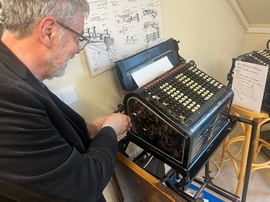 We replaced the metallic left side panel of our restored Burroughs machine with a transparent Plexiglas window giving a view on the impressive system of levers. After waiting without success for the cutout to be made by a German company specializing in Plexiglas cutting, Claude Baumann made the work on his refurbished CNC machine, using his special written software (link). The fit was perfect! I added a LED strip for illumination. |
Done. | ||
|
PYTHON compiler for the HP-65 (v.1.3, PDF) LillyPython code v. 1.34 (zipped folder, with executable, a library of examples and full source code) |
BAUMANN Claude (minor help from Massen Francis)
Baumann Claude |
A HP-65 Fiftieth Anniversary Project
This is a huge 54 pages report on the creation
of an original Python compiler for the 50 years old HP-65, the first
programmable hand-held scientific calculator of the world introduced in
1974. Recursive routines using the Labview programming environment are
created to produce a virtual instrument (VI) allowing to input simple Python
programs to create the HP-65 specific routines. The report is divided into 2
parts: Here the first screen you get after running
LilliPYTHON1.34.exe: Claude Baumann has created here a practically world-unique software package,
using his extensive skills of Labview, recursive programming and
compiler building. |
Python compiler done. HP-65 repairs nearly done. |
||
| MERCEDES A21 |
MASSEN Francis (Mar 2024) |
 I auctioned a Mercedes A21, the first printing calculator made by Mercedes at Zella-Mehlis (DDR) in 1951. It is in good shape, but I was foolish enough to remove the plate below the keys (to clean it), and spend an anxious hour to replace the keys into their correct position (where they are kept by the white metal plates). I pity the poor workers who had to assemble this mess. The machine now works top-notch. This rack and pinion printing machine has a similar system with moving stamps as the Brunsviga AS8 (see below), but here the hollow rods are linear and not curved. |
Done. | ||
| MERCEDES-EUKLID M30 Stopdivision ("funzionante") |
MASSEN Francis (Mar 2024) |
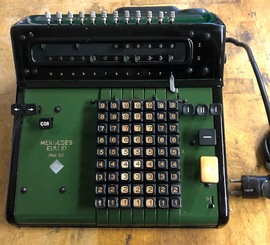 I auctioned a 2nd Model 30 with Stopdivision to augment our stock for the next workshop to be held in May. This is a nice machine, sold from Italy (and presented as "funzionante"), but in real good visual condition. There was one problem with the electric motor which did not shut off but rotated constantly. I was able to bring it back to normal behavior by mounting off/on the switching assembly and disabling the surge suppressor caps (our other model 30 has a different motor without these capacitors). The keyboard is very vintage, certainly pre WW II, with small celluloid (or glass) covers on the keycaps; I guess it is from 1937-1939, the serial is 37554. Someone must have lost the right "III" keycap to release the keyboard, and replaced it by a "I" cap ("I" clears the operation counter). The "plus" keycap color has changed from red to yellow. All functions are ok. |
Done. | ||
|
IBM SELECTRIC III correcting type XYD |
MASSEN Francis (Mar 2024) |
 One of the IBM Selectric machines donated by A. Ypsilandis had a carriage movement which stuck when the carriage arrived at the middle position. I first suspected a TAB setting/clearing problem, but the culprit was much more fundamental: the right black plastic cover shown in the picture above was slightly deformed, with it's too high left border blocking the carriage. Repair was easy: one plastic piece glued in to pull down the cover. The machine is without any visible blemishes, but from time to time some sequential letters are too close. 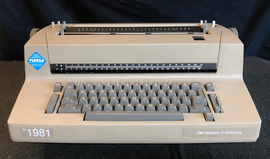 |
Done. | ||
|
MERCEDES-EUKLID Model 30 with Stopdivision feature. see video |
MASSEN Francis (Feb 2024) |
 I auctioned a Mercedes-Euklud M30 (the Stopdivision variant) on Ebay. It did not work, the power cable was brutally cut off, the collector of the electrical motor was a gooey mess etc..., but the external aspect is excellent, and also the inside in very good shape. Spending about 6 hours cured most problems. The "Stopdivision" feature is quite strange, and you may look at the video for a demonstration. This is one of the many machines I am preparing for our upcoming Science Day in May. |
Done. | ||
|
BRUNSVIGA AS8 printing calculator, (1950) see album |
MASSEN Francis (Feb 2024) |
I auctioned for a very good price a nice and relatively
rare mechanical Brunsviga printing calculator AS8, based on a
toothed-segment (not tooth-bar!) mechanism, and a design by US citizen Ralph
COXHEAD from the 1930's. The machine had several problems, but is working
now at 100% after one day's work and cleaning. The picture below shows the calculator with its hood removed. The 4 red keys are for Repeat (left), Subtract, Sub-Total and Total (right, from top to bottom). 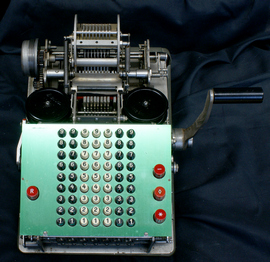 |
Done | ||
| HP65, HP67 |
BAUMANN Claude (minor help from Massen Francis) |
A big project to restore these programmable calculators from the 1970's. Restoring the magnetic tape readers is difficult work... Sorry, but I will not talk too much of this for the moment to not spoil a big upcoming event. | Ongoing work | ||
| MONROE L160-X |
MASSEN Francis BEERENS Niels Marco GOFFINET (Feb 2024) |
Our member Claude BAUMANN donated a vintage Monroe
calculator (of the split-stepped drum type) from the 1940's (many thanks!).
The beautiful machine was completely blocked due to hardened grease, and was
damaged by a fall which had bent several carriage items. Niels (our
technician of the physics lab) managed to straighten the bent carriage
guide, and I did the rest. The calculator now works flawlessly, but we need
to print two missing key caps. Update: this was done by Marco, who is the manager of one of our Maker Spaces. |
Done | ||
|
Burroughs Class 1 and Mercedes Euklid M1 |
MASSEN Francis (Jan 2024) |
1. From time to time a restoration must be abandoned, and this is the case with the Burroughs Class 1 (see 2 comments below). Despite working many, many hours on this hand-driven calculator form 1911, I had to abandon work. There is a problem deep inside the printing gear, that I am not capable to correct. With some tricks, the machine can add and show the result on the wheels, but that is all. It will be exposed now in the naked state besides the restored big Class 2 machine, so that the inner workings are clearly visible. 2. (updated) We have a very old and rare Mercedes-Euklid M1 machine, serial number is 3772, so probably from 1921 (according to the table in the Martin Reese article "Zeittafel, Nummernlage und Modellübersicht für die Mercedes-EUKLID und Mercedes-Addiermaschinen"). I put it aside many years ago in a blocked state. There are a couple of problems: a mechanical clamp and a part of the crank foot is broken away, and there are the usual gripping and blocks. The crank can now be turned, the wheels move freely, but the correct addition and carriage displacement still do not work. So this will be ongoing work for the next weeks... Update: the machine is unrepairable, due too too many faults from bent parts by a former fall. The machine is now exposed "as-is" in our large magenta cabinet. |
Ongoing work, than done. | ||
| Burroughs Class 2 Duplex (BCEE) |
MASSEN Francis BAUMANN Claude (Dec 2023) |
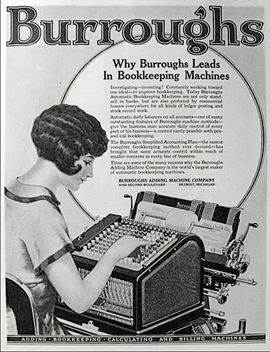
The restoration is nearly done.
|
Mostly done | ||
|
BURROUGHS Class1 and Class2 29Nov2023: see small no-frills video of the machine working. |
MASSEN Francis (Nov 2023) |
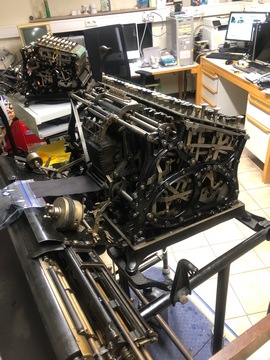
We have two very old Burroughs printing adders, they are
more of a booking-machine type. The Class 1 (from 1911, serial 9-174439) is
a 9 column manually driven machine, the Class 2 a heavy 60kg beast with an
electrical motor (17 columns, dual totals, probably 1926) which was used by the Banque et Caisse
d'Epargne de l'Etat (BCEE) in the 1920/30's. Both are shown in the Computarium,
but neither works. |
Ongoing work | ||
| Blocked FACIT ESA0 |
MASSEN Francis (Nov 2023) |
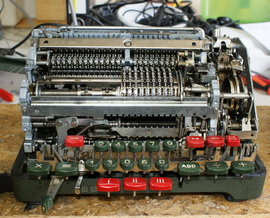 
This electrical FACIT ESA0 calculator is exhibited in a
transparent Plexiglas enclosure, and regularly shown in operation. This
morning I found that the machine was completely blocked. I brought it on the
workbench, and tried to free the pin wheel drum that was blocked at the left
side of the machine. Fiddling around and switching the motor on off finally
started the machine unexpectedly, with the drum sinking a sharp metal nose
deep in my left finger. Blood flowed like hell, but our housekeeper Guy
Weber (which knows how to make first aid) very professionally put a band-aid
that stopped the blood... running down from 3rd floor attic to ground level
nevertheless left a bloody trace! As you may see, restoration work is not
only an intellectual pleasure, but may be challenging for your physical
health! |
Repair done. | ||
|
Repairing a Burroughs Class 5 calculator (link) |
MASSEN Francis (Nov 2023) |
Lab report on the restoration of this key punch calculator from 1925 (see also 2nd row below); thanks to John Wolff for help! | Done | ||
|
Development of a Labview G-Code generation program for
2.5D CNC contour offset toolpaths (link) |
BAUMANN Claude (Oct 2023) |
54 page very complex lab report with original software. The problem was to generate from an .SVG image the G-Code to drive a CNC drill or Laser Cutter, respecting the problems caused by the dimension of the tool used. Strong mathematics! | Done | ||
|
BURROUGHS C5 (1925) 21-Oct-2023: Now most column work, and the crank turns easily. See video showing how the carry goes from right to left. |
Massen Francis (Oct 2023) |
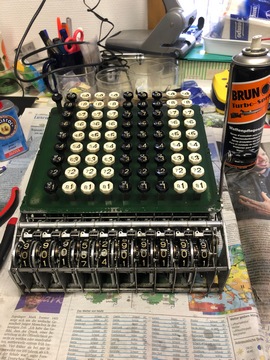
Anne BAUMANN (daughter of our member Claude) donated a
rare Burroughs Class 5 keypunch calculator, for which we are very grateful
and say many thx!. The serial number suggests the machine being from 1925.
It is in an excellent visual state (exterior and inside), but totally
blocked, crank and keys and dial wheels are stuck.. The machine stood
probably 50-60 years somewhere without anything moving, so the complex
planetary system to make the carries is blocked. Loosen these parts is a job
for a Benedictine monk: it took me at least 40 hours to make finally 6 of
the 9 columns working. I can not find any technical manual, just two videos
on Youtube where the guys also complain on the work... |
Ongoing work. | ||
| THAT Analog Computer |
Massen Francis (Oct 2023) |
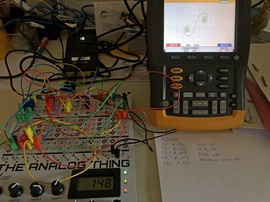 The Computarium acquired a brand-new THAT analog computer built by the new Anabrid company founded by Prof. Dr. Bernd Ulmann. Here it computes an Euler (or Cornu) spiral and displays it on a Fluke oscilloscope. The THAT is fiddly about clean power supply, I use a USB Powerbank which works just fine. |
|||
|
BURROUGHS "P" printing calculators from 1953/1954 See short video! (5:11) and album on the P685. |
Massen Francis (Jun 2023) |
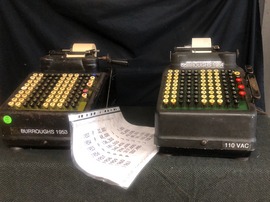 I restored two Burroughs class 9 printing adders: one crank driven from 1953 (at the left) and one from 1954 driven by an electrical motor. The first (donated by Marcel Baumann) was in a bad shape, with awful lint and dust inside, and also much rusty corrosion. But after a thorough cleaning it worked flawlessly (I really was surprised!). The electrical model (which some years ago I auctioned on eBay) is in a very nice state, no rust, no dust, and it purrs like a cat. |
Done | ||
| LEXMARK 4079 Plus repair |
Massen Francis (Jun 2023) |
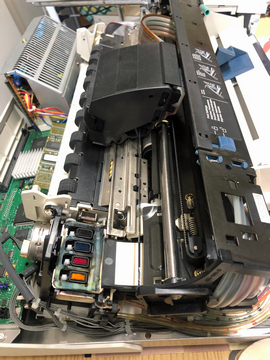
One of our two vintage A3 inkjet printers was unable to
print black. The K print head is definitively dead, and was replaced by the
Yellow one, so that we now have a K C M only printer. Click on image for a
short
album. |
Done | ||
| RETRO JUKEBOX exhibited |
Massen Francis (May 2023) |
 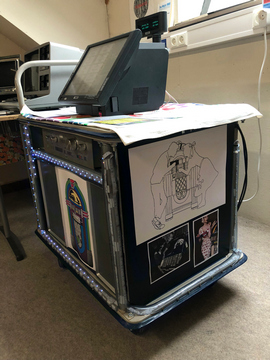 A protection of the RGB LED stripe was missing, so I added transparent plastic water hose pieces (cut in half or simply with a longitudinal slit) over the LED's, and some decoration on the side panels. The Jukebox is now a playable showpiece in our first room in the main exhibition. |
Done | ||
| Repair of a TI-30 calculator |
Massen Francis (Mar 2023) |
I "repaired" a vintage TI-30 scientific calculator from 1976 donated by Mr. E. Lacoste. See album and very short video. | Done | ||
| A House of Arts and Music |
Massen Francis (others to come...) (Mar 2023)
|
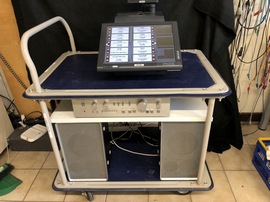
The Computarium participates to the late night organisation (29th April) of our lycée, with a Retro Juke-Box playing 8-bit games music and several very vintage (1970's) games, which will be mounted near our big cabinet, with a lot of bells and whistles. The upper picture shows the JukeBox which really is a vintage Epson POS; the lower shows an old rolling cabinet with a very heavy Philips TV set and a PONG and ATARI 2600 video game. The Atari runs the FERRARI play. More at the exhibitions page. |
Ongoing work | ||
| TIM UNITAS II repair |
Baumann Claude Klein Jean-Paul Massen Francis Massen Gilles Ramel Sophie (Jan 2023) |
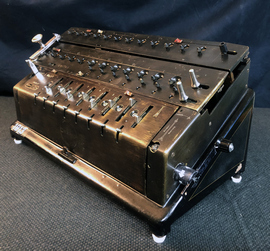 Many people were involved in this repair. This very rare machine is now working 100%, and exposed at the Computarium. See album! |
Done | ||
| Atari SF354 floppy drive belt replacement; Mega2 internal floppy drive repair. |
Massen Francis (Jan 2023) |
Jos Kayser donated an Atari Mega 1 system, which had a
non-working external SF354 floppy drive. The rubber drive belt was broken,
partially changed to goo. By chance, the Amstrad floppy drive belts fit very
well, so this was not a difficult "repair". A Mega2 donated by P.
Felix had an non-functional internal floppy drive (DSDD). Here the upper R/W
head assmbly had detached itself from the holding structure. Both drives are
now functional again. See the short album! |
Done. | ||
| Aesthetics decoration |
Massen Francis (Dec 2022) |
In the legacy of our late colleague, friend and member
Jean Mootz I found a rare vintage GUNDELACH Luko high-power X-Ray
tube from 1925, probably used in an XRAY machine for lung screening ( at
35kV? ). Gundelarch was a German glassblower company that in 1896 (only one year after Roentgen discovered the Xrays!) made the first Xray tube ("Roentgen tube"). Our item is a passive device with a non-heated cathode and and an anode (formerly called "anti-cathode") passively cooled by metallic wings on the outside. The tube has the Gundelach "regenerator" device, a special side-mounted tube containing a metallic roll covered by some element which when heated by a large current, absorbed the traces of gas which developed over time in the inner tube (which should be at vacuum). The tube is mounted above our Millionaire calculator, which is also a device from the first decades of the 20th century. More on Gundelach tubes and other Roentgen tubes here. |
|||
|
HP16500A logic analyzer (LA) and Digital Signal
Oscilloscope (DSO) PIC based signal generator (lab report on this PIC generator here.) |
Baumann Claude Massen Francis (Nov-Dec 2022) |
We mostly finished our latest "rolling" exhibition of the
vintage HP16500A. We were able to find in a surplus shop in Israel the 2 boards that add the DSO capability to the HP16500A mainframe. Visually, the 2 boards were not shining new, but there was no major corrosion or other defects. In our 6.0 OS we had the module SYSTEM_011 to command these boards, and with really good luck both worked when cleaned and mounted in the mainframe (one test shows a failure in the interpolation circuitry, but this does not seem to cause a major visible fault). Switching on now shows the 3 modules LA and DSO (timing and oscilloscope), see the left picture. A triangular wave is displayed by the DSO on the right picture: We wanted to show the LA function without many clutter; so Claude built an 8 channel signal generator using one of his PIC's, all this in a small case holding the PIC and a 9V battery: CH.0 is an UART serial stream, sending the text "COMPUTARIUM" in regular bursts. Ch.1 is the pulse wave triggering the send of transmission; the next 6 channels are pulses with smaller and smaller frequencies (mostly dividing the previous by two). Here a screenshot of the signals captured by a "modern" Kingst LA1010 USB LA (highly recommended!): See the lab report on this PIC generator here. |
Mostly done, some cleaning and text adding waiting. | ||
|
ASR-32 Telex on dolly Recall: version 1.1 of the lab report on creating the TTY/USB converter is here! 3 minute video here! |
Baumann Claude Massen Francis (Nov 2022) |
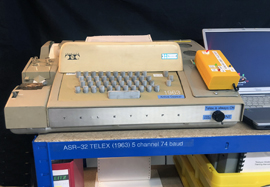 The 1963 ASR-32 Telex restoration is mostly done; the whole equipment is mounted on a wheeled dolly, together with a laptop running Teraterm; Teletype documentation (in yellow cradle) is stored below. The TTY/USB interface is fixed by Velcro so that the Receive/Transmit toggle switch is in easy reach, and that the box can quickly be removed when needed. A "Figs" problem caused by dirty signals has been solved by adding a 1 MF capacitor on the receive line (i.e. the line receiving the data from the Telex). All functions including tape punching and reading now work like a charm. The front panel has been salvaged from an ASR-33, as that of the ASR-32 was missing. |
Practically done. | ||
| Dolly mounting & Cabinet repair |
Massen Francis Waldemar Lichy (Oct & Nov 2022) |
Not all work in the Computarium is challenging
"intellectual" stuff... Sometimes really down to earth craftsman's work must
be done: 1. The 31th October my brother in law Waldemar helped me to mount a dolly; several pieces did not fit, so this normally easy 1 hour job took us nearly 3 hours to finish, which much sweating and ugly comments: 2. Yesterday (4-Nov) I saw that a large cabinet which
holds a part of our software collection has crashed: the highest board
became loose, and fell down on that below, starting an avalanche until all
boards were down. Here a picture with the first 2 boards cleared away: I made new sturdy supports which are now held by metal screws, and not by the former plastic stubs which were unable to support the weight: BTW these cabinets are disused equipment of the
physics department of the Lycée Technique Hôtelier Alexis Heck (now
EHTL), donated by my late wife Colette;
the Computarium recycles whenever possible! |
|||
|
TTY/USB converter for Telex ASR-32 Read version 1.1 of the lab report on creating this converter here! (update!) |
Baumann Claude Massen Francis (Oct.2022)
|
Claude has built a TTY/USB converter for the ASR-32
Telex, which allows communication between a PC (using a serial terminal
software, 9600-N-8-1) and the 5-bit ASR-32, that runs at 74 baud. The
converter was heavy work, with Claude pulling all strings to program a PIC
using the PICLAB software, Assembler and Labview. The device is a small box, which many LEDS showing Rx/Tx and FIGS/LTRS settings, and having a FT232R USB/serial converter on the PC side, and a 3 wire connection on the ASR-32 side: Claude has managed to set the different timings (using complicated interrupts) so good, that the interface manages to correctly interpret the terrible signals sent out by the ASR-32. The left picture shows what the Telex sends to the PC, and the right the smooth signal in the other direction PC to Telex: There remains one annoying mechanical problem with the
carriage return, which is not executed, neither in local mode by pushing the
RETURN key, nor in ONLINE mode when receiving it from the PC. But the
electrical communication works without any fault on this device, which
probably is a world-première! |
Electronic work finished. | ||
|
TELEX ASR-32 HP 16500A |
Baumann Claude Massen Francis (Oct.2022) |
Our ASR-32 Telex is quite remarkable: it has
a 220VAC transformer and a 50Hz motor, so you would think that this machine
used in Europe should adhere to the old EU standard of serial telex
transmission (50 Baud, 10 ms bit duration), but this was not the case here:
our Teletype model operates at the old US standard of 45.45 baud, with
a transmission time of 12ms per bit, and 31ms for the not quite 1.5 stop
bits. It could be that it was in usage at the US armed forces present in
Europe.
Claude who is a really expert in PIC
microcontroller programming and Labview usage had built a small ASCII
to BAUD serial converter, allowing to send text from a PC with 9600
bit/s and usual parameters to the ASR-32 which receives it at a much slower
speed and different start/stop parameters. His interface has a DIP switch
which allows to try out the many different parameters that exist. Our first
surprise was that the ASR-32 (which has a 3 wire output, and not the
standard 4 wire dual loop) curiously is an active device (all ASR-33
teletypes are passive), working in half-duplex. We rather quickly found out
the working combination and could send text from a buffer to the telex. The
other way round still has some hiccups, but changes in the programming
should resolve this. There is a common GND problem between the Rx and Tx
lines that we are unable to solve, except by adding a toggle switch to
change between sending and receiving. Claude will build a small electronic
module to handle the transmission and code changes between a PC using its
serial RS232 port and the ASR-32. The Computarium acquired an HP16500A logic analyzer (probably from 1992), which they called a "mainframe". It is very heavy, uses a Motorola 68000 uP and has two 3.5" 720kB (DD) floppies as storage medium: one at the rear which holds the system, and one on the front where configuration files etc. can be stored. They use the HP LIF file structure which is non-compatible with DOS. It is a beautiful beast, with a single module for the logic analysis. With a bit of luck we may find the DSO module (a digital oscilloscope board) which would be an interesting add-on. We were able to make an image of the single system disk (OS v. 5.01) present, using IMAGEDISK. But LIF formatting and disk duplication also works fine on the 16500A itself. I found DOS versions of SYS 6.0 at archive.org, and was able to create the first system disk using the LIFUTIL utility software of HP on our DOS CopyStation. Again, many new things to learn, as both Claude and myself are neophytes in this domain of logic analyzers.! |
Ongoing work | ||
| Different Teletypes |
Massen Francis (Jun/Jul 2022) |
 I restarted work on the ASR-33 donated by Carlo Mullesch (a 115VAC model, where I added a 220/115 transformer into the stand). Everything works fine, with the exception of the automatic tape reader, which refuses to start either manually or through software commands (but it works by manually pushing the trip lever). The problem probably is caused by one of the 2 power supply/relay-logic modules in the stand.
_____________ I finally made something of a kludge to bring the tape reader to work: I routed a 117VAC line via an On/Off switch directly to the solenoid of the trip-magnet; this switch is mounted on the frontpanel of the stand: switch it on, and the reader starts, switch it off and it halts. This bypasses all "automatic" logic and relays, and also the manual (and broken) start lever, the tape-out and tape-tight switches. It works very well!
The call unit of this model is somewhat particular, with
5 square switches each sitting on a relay. I did not find any information
for this wiring, so this part also is switched off with no regrets! So this TTY now works fine, as do the puncher and reader.
end 04 Jul 2022 I also switched on a very old TTY (donated by Jean Mootz+ in 2012), which resembles an ASR-33 but in fact is the 5 bit version ( 32ASR or ASR-32, typename on plate is 32 TAJ). It works with some faults of wrong decoding, no CR, but the tape puncher and manual tape reader seem to be fine. This is a 220VAC model with a big transformer and a curious keyboard with FIGS (figures) and LTRS (letters) keys to switch on the upper rows of numerals or the lower 3 rows of characters; no SHIFT and CTRL keys. This keyboard has 4 rows of keys, whereas the ASR-32 normally should have only 3 (see here). This machine was used by WESTREX. (a Western Electric subsidiary) and probably bought by Jean Mootz at a "stock militaire" ( = military used equipment store) in Belgium. Look at the tape reader which has a "normal" 8 hole plate, but only 5 pins to sense the holes in the paper tape and stubs spaced for the narrow 5bit tape...
Today I got all keys/codes and the tape puncher and
reader working properly, with the exception of a non-responsive RETURN key,
and also no automatic CR/LF after the 72th character printed. This and the
non printing of numerals remain the last 2 problems. Connection to a
computer via the Horter V24/20mA converter has not yet been checked. |
Ongoing work | ||
| PDP-11/34 non repair album... |
Massen Francis (Jun 2022) |
PDP-11/34 non repair ongoing album is finished! | Done. | ||
| TELETYPE ASR-33 on OSI computer |
Massen Francis (Jun 2022) |
We have a working demo exhibit with an TTY ASR-33
(115VAC model) connected to an OSI single board computer with 3kB BASIC in
ROM. The TTY started making very disturbing, ratchy noises after a few
minutes, or even seconds of running, and needed an emergency shutdown. I did
not see anything mechanical becoming loose, so oiled most rotating axis and
bearings with silicon oil. This helped somewhat, but the problem did not
disappear. Finally I put white lithium grease on the plastic sprocket
wheels, because the noise could be caused by one wheel ratching over the
second which demanded too much torque. This helped definitively (tongue in
cheek!). As there was than another problem with the print head not printing,
I first build a second V24/TTY active converter from a Horter kit (easy to
build, inexpensive!, see second photo), and operation with Teraterm on a XP
laptop (110, 7bit, no parity, no flow control, 2 stop bits) was ok after
some supplementary cleaning. The paper tape puncher of the TTY works fine,
but the reader does only return gibberish...I do not find the fault. But
this is not needed for the demo... |
Done (hopefully!) | ||
| DEC VT180 and RX180 |
Massen Francis (Jun 2022) |
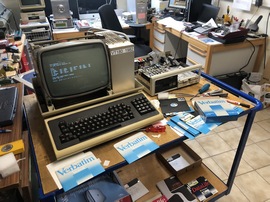 The DEC VT180 (anno 1982), a VT100 terminal modified to become a computer by adding a Z80 board, was ill: only a single line was shown on the CRT, and the second floppy drive was missing. The first problem was easy to solve, a contact problem. The second was more difficult: in my collection of big 5.25" drives I found none that worked flawlessly. Finally I found a narrow Matsushita drive, that when used as drive A: and configuring the original DEC drive (a Shugart 400, SSDD) as B: made a successful CP/M 2.2 (v.1.0) system. This system runs MUSIMP, the famous system for doing symbolic calculation developed by the Software Warehouse in Hawaii from LISP, starting 1976. The VT180 was donated by Jean Mootz (+), who was a fan of symbolic algebra. |
Done | ||
|
DEC PDP-11/34 PDP-11/34 non repair ongoing album! (last update: 25Jun2022, album finished!) |
Massen Francis Baumann Claude Scheer Tom and Makerspace crew |
 The (non-working) DEC PDP-11/34 system has been definitively brought to its resting place near the flashy magenta Computarium cabinet suite. The upper panel has been replaced by a plexiglass window allowing to peek inside and see the numerous boards. A lock enables to open the upper RL02 drive drawer for demonstration. The bottom panels have received new (yellow) fixations which have been printed by our Makerspace crew (Scheer Tom). The picture shows the old fixation with broken off holders and the new yellow models made on the 3D printer. Posters at both sides of the rack give further explanations and QR links to videos about DEC and the PDP-11 minicomputers. An album showing the several months long repair effort will follow asap... stay tuned! |
Done | ||
|
1. ATARI PORTFOLIO 2. PDP-11/34 |
Massen Francis and some (May 2022) |

1. Our contributor Nico Beckerich donated among
other items an Atari Portfolio in mint condition, with memory card (which is
seen as drive A:) and parallel and serial interfaces (the 2 modules left and
right on the picture). I tried with the these to make transfers from PC to
Portfolio and vice-versa. Running the FT.com on a DOS PC allows
transfers via the parallel port using the inbuilt features of the Portfolio.
Making transfers through the serial port was a bit more complicated. I made
a new Nullmodem cable (with CTS-RTS jumpered together, a must for the
Portfolio) and tried AMCOM (same software on Portfolio and PC); a subset of
the features worked. But best results were obtained by installing XTERM2 on
the Portfolio, and using TERATERM on a Windows PC (albeit a WIN2K machine I
use for this serial stuff) and transfering with XMODEM. Sure, getting XTERM2
into the Portfolio is a bit a chicken and egg problem...
|
1. Done 2. 80% done |
||
| DEC PDP11/34 |
Baumann Claude Massen Francis (Mar 2022) |
Ongoing work on the PDP-11/34: we reassembled the heavy
power supply: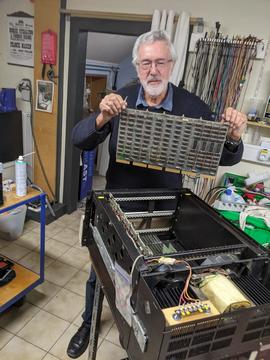 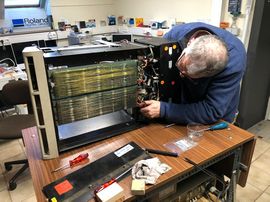 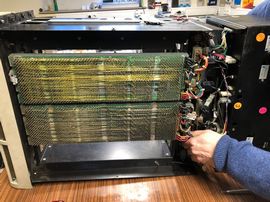
and tried to achieve a communication via the DL11 serial board: no success for the moment. |
Ongoing work | ||
| Burroughs B22 |
Massen Francis (Feb 2022) |

Jean Wagner donated a Burroughs B22 system (actually built by Convergent Technologies in 1981) consisting of a client station and a master computer (a tower), The client is a nice assembly of monitor and i8086 computer on a common base. The monitor was crippled with white fungus, which had grown in the explosion protection plastic sheet (ca. 2mm thick) covering the glass CRT. The glue between glass and plastic had partially liquefied, and removal and cleaning was quite a job. The computer boots with an SOS-beep, possibly because I do not yet have the keyboard (which will be delivered asap). The monitor remains off, possibly because of the non-booting state. I am unable to find any technical details on the 20 pin square connector from the video card to the monitor, which seems to be a CGA or variant digital type (not a BAS) monitor). Any help will be appreciated! The client station has no floppy drive neither HD, so relies on the server which has a 8" Shugart 8" floppy drive and an enormous HD. Again, no documentation, no software! Interestingly the material seems to come from Piedboeuf SA, which is a famous Belgian brewery in Liège! |
Ongoing work | ||
| DEC PDP11/34 power supply |
Baumann Claude Massen Francis (Feb 2022) |
The 35 kg H650 power supply was separated from the main cabinet (see upper picture), and all power modules (H744 = 5V, H745 = -15V and 5411086 = +15V) cleaned and checked under load. It was very difficult to separate the Mate-N-Lok connectors who were very tight. All power modules are ok, with no big ripple on the regulated voltages. Reconnection will be done next month, this is a 4 hands job as the wires from the backplane to the connectors are very short, and the H650 so heavy! |
Ongoing work | ||
| DEC PDP 11 terminals |
Massen Francis (Jan-2022) |
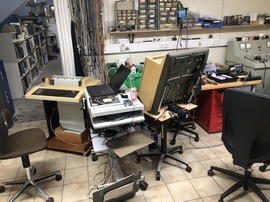 Two terminals came with our PDP11/34, donated by Guy Schintgen. The Decscope VT52 is in bad shape (this is the big thing at the right showing its bare underbelly!), the monitor screen does not display any cursor or characters, and on one of the big motherboards the IC voltage is 4.75V, a bit too low. I am searching for the cause. The Decwriter III (LA-120) which is on the left of the picture had many unresponsive keys, among them the most important SETUP key. But luckily, the culprit were bad contacts. As the key mechanism is a wonder of simplicity and easy to access, that repair was gratifying! The serial terminal needed a good deal of cleaning, and I built a platform with rollers to make moving it more easy. On the picture the Decwriter is wired by a null-modem cable to a laptop running Teraterm (at 9600 bit/s), and everything works very smoothly! PS, Feb.2022: : After 3 days of good work, the Decwriter has become seriously ill: on power up, the print head does not move (to its resting position left), and it shows a constant "Paper Out" fault (the paper switch is ok). Not sure were the problem is (encoder? bad motor driver?).... Such is life for a restorator, do never become too confidant! |
VT52 going on DECwriter III: restoration done. |
||
| IBM modified Selectric type writer and text processing unit |
Massen Francis (Jan-2022) |
Among the items donated by Marco Barnig was an IBM
Selectric, that had been modified to be driven by a text processing unit. MB
built this unit during his time as an assistant at the ETHZ (Eidgenössische
Hochschule Zürich = Technical University of Zürich, Switzerland). Alas, the IBM Selectric is beyond repair, at least for me. Several steel traction ribbons have become loose, and I am unable to put them again in proper position. |
Unfinished, on hold. | ||
|
CT-1024 terminal (SWTPc 6800 system) |
Massen Francis (Jan-2022) |
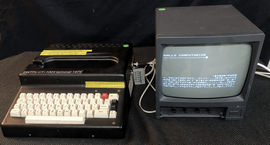
The CT-1024 (also called TV-Typewriter) was the original alphanumerical terminal sold as a kit with the SWTPc6800. It has a RF modulator to be connected to the antenna port of an ordinary B/W TV, which so became the display of a cheap computer terminal. Jean Mootz (+) and I built each one of these in 1977, and this is Jean's. He made a modification with the external connectors and added a RS232 DB25 socket. The "normal" baud-rate was 1200, switchable to 110 (= the baud rate of the famous ASR33 TTY). Here 1200 works unreliably, so the default is 110 (N81), with an internal switch for 1200. Notice the many "flying" wires on the different circuit boards. The CT-1024 kit was introduced in 1975. Look also here. |
Restoration done | ||
| SWTPc 6800 repair |
Massen Francis (Dec-2021) with big help from Mike Douglas (deramp.com) |
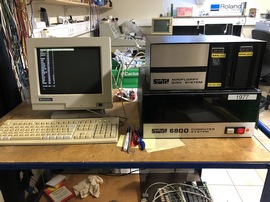 I tried to bring back to life one of our old SWTPc 6800 computers that my colleague Jean Mootz (+) and I assembled in 1976/77 (look here for the catalog). The tin contacts of the SS50 motherboard were badly corroded, but a MP-A2 CPU board with the SWTBUG Rom worked "out of the box". I fixed an MP-S ACIA serial board with some new solder, and used a 300 bd speed for serial communication, first with a laptop, than later with a real serial terminal. A GIMIX 32kb memory board looked like new, with it's silk shining intact after more than 42 years. The two 5.25" floppy drives are the original Wangco SS, SD 35 track drives. One had a bad bearing, but some silicon oil corrected the problem later on. I found only one last TSC Flex 1.0 system disk (Flex 1.0 manual here), all other were Flex9 for the SWTPc 6809. As I had only a one working drive at the beginning, relying on one single diskette was very strenuous. I tried Imagedisk, Anadisk, CopyIIPC, Teledisk etc. for imaging, without great success: impossible to make a bootable copy of the image of the SD 128bytes/sector system disk, that has a track 0 different from the remaining ones. My best result was a copy that was partially readable, but could not boot; visually comparing the dumps of the original and the copy did not show up any difference, so this remains a problem; I am grateful for every serious suggestion! After a treatment with silicon oil the second disk became usable, and I could make backup's of the Flex 1.0 system disk. The original SWTPc CT-64 terminal (assembled by J. Mootz) works, but loses characters even at the slow 300 bd.. The "newer" CT-82 has a bad video monitor. So I finally attached a much newer (1997) Televideo 990 terminal donated by Carlo Mullesch, which gives a splendid readable display. BASIC, TSC Editor and Assembler are on the system disk (Flex 1.0 was also called "miniFlex" or even "FDOS" at the beginning). I am still flabbergasted how much software the old developers could put on a single diskette! So the last serious problem remaining is the making of a correct bootable image of the system disks. I know that Vetusware has this on top of its priority list! PS:I exchanged many emails
with Mike Douglas, who is an absolute expert in vintage computer
restoration (look at his breathtaking website
deramp.com). He wrote two assembly programs to make Flex 1.0 images
using a SWTPc 6800, which does not need to run an OS (only the monitor
SWTbug is needed). His programs allow to convert a floppy disk to an image
(to be sent via the serial line to a PC for instance) or to make a new
floppy on the SWTPc by sending the image file from the serial terminal to
the SWTPc. He also wrote a new much faster disk backup software executable
on the SWTPc. |
Repair done | ||
| MOTOROLA EXORset30 repair |
Massen Francis (Nov-Dec-2021) |
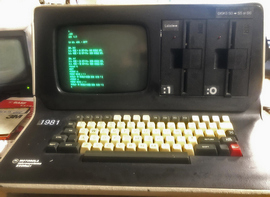
We received a Motorola Exorset30 microcomputer (1981)
from Nic. Malget in 2010. The computer was in use at Circuit Foils, a
company in the northern part of Luxembourg that produces the copper foils
which you find on the electric circuit and motherboards. The computer has
two 5.25" BASF 6106 drives, which are single-sided only, and a FDC (floppy
disk controller) which is pre-standard (w.r. to the IBM PC). One of the
drives was defunct, but the famous EXORbug monitor prompt showed up. It took
me a long time to replace the 2 drives by old Tandon 100-2A models (and to
find drives that still worked!), the same that were used by IBM (and these
here have IBM embossed on the front!). I had to make small changes on the
motherboard of the drives, as the controller waits for a READY signal which
is not delivered by the Tandon and other IBM compatible floppy drives. I
also had to rebuild my copy station with a "faster" 486 board, and a SD
capable controller to make .IMD files and recreate 5.25" disks. We now have
3 versions of the XDOS OS: XDOS 3.01, 4.0 and 4.13. The latter seems to have
practically vanished from the universe. I found a xdos413.dsk file on the
Net, which was corrupt, and had to reassemble the full set of 4 original
disks (they are now available on Vetusware). |
Repair done | ||
| COMPAQ 386 Portable III repair |
Massen Francis (Nov-2021) |

I wanted to use this beautiful machine we received in
2005 for making 720kB floppies from TD0 images. The first hours in operation
were fine, but than the problems were creeping up, with a hard disk becoming
more and more irritable. See the
album for more details. |
Repair done. | ||
| HP 9826 |
Massen Francis (Nov-2021) |

The "restoration" of this beautiful HP computer (sold
for scientists and engineers) owns much to other people. Let me mention
first the Vintage HP computers systems group in groups.io, for
giving much needed information very fast, including images of HP software on
diskettes, and bitsavers.org for the manuals. Two key stubs were broken, and in first try I managed to glue them together with cyanide glue. Time will tell if a more solid fix is needed. |
Work in progress... Done (Dec. 2021) |
||
| OLIVETTI L1 M40ST |
Massen Francis (Nov-2021) |

I restarted working on this beautiful machine that we
acquired many years ago from an "Ingenieur-Büro" in Essen, Germany. The two
8" drives work perfectly, but we had no documentation at all, and it is not
easy to find. M. Heiko Schumann , an Olivetti-only collector (see his
beautiful web-site olivrea.de) gave me
access to the most important manuals. The computer boots into Basic, and
from there executes programs and system routines. I was finally able to find
several system diskettes among those we got from Essen, and to make copies
on the L1 M40. |
Work in progress... | ||
| DEC PDP-11 front-panels |
Massen Francis (Oct-2021) |
 Carlo Mullesch donated last year also three original front-panels from DEC PDP11 8/I, /55 and /70 minicomputers. They are now on display in the Computarium . |
Done (1 LED bar for illumination will be installed later) |
||
| HP85A (contribution G. Maurer) |
Massen Francis (Oct-2021) |
 Gilbert Maurer donated a nice HP85 machine with its large carrying case; it is a 16KB Ram computer (the 32 KB sticker is wrong), with Basic in Rom. a thermal printer and a data cartridge drive. Here a picture of the open machine (which works flawlessly): The tape drive has originally a capstan covered by plastic, which drives the brown front wheel seen in the second-next picture. Here the plastic has crumbled away; I tried replaced the plastic by a shrink tube. An insurmountable problem is the unusual mechanism inside the data cartridge (made by 3M for HP): the tape wheels are rotated by a plastic loop band, which itself is moved by the capstan pressing against the brown wheel seen at the front. This loop is broken and split on all cartridges we have; here in the picture I replaced it by a yellow rubber band to show the working: Here a blow-up view showing the yellow loop band which rotates the tape reels by friction against the data tape. This clever mechanism with a constant length loop is compatible with the increasing/decreasing diameters when the data tape is moving from one reel to the other. |
Data catridges impossible to repair. | ||
| TSM Workshop |
Massen Francis Lavina, Marc (05-May-2021) |
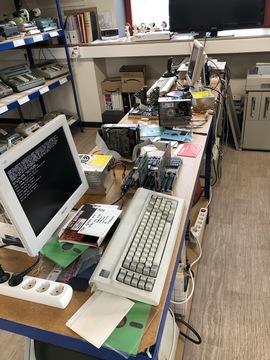
Our TSM ("Talents, Skills and More") workshop was held
today; 4 very young students of our 1st year participated. The aim was to
assemble a working XT-clone (with a 8088 uP), launch DOS 3.30 from
5.25" floppies and learn some rudiments of BASIC (MSBASIC). |
Done. | ||
| Presentation case with Soviet and Eastern block microprocessors and support chips. |
Massen Francis (Apr-2021) |
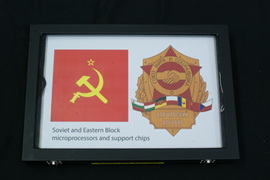
The Computarium's miniscule Soviet vintage uP's collection was greatly enhanced by a lot of similar material from Carlo Mullesch. I introduced a new 6th section in our virtual museum for the microprocessor and support chips category. The first section finished is that of the Soviet and Warsaw Block origin. I assembled all these chips in a "beauty-case", so that they may easily be stored away and shown in one of our 3rd floor cabinets. The yellow labels are the database indices, and the white page seen behind the glass cover is more explicite. |
Done. | ||
| MACINTOSH revision |
Massen Francis (Apr-2021) |
 From time to time you see extraordinary things when opening a computer. Here is the motherboard of a vintage Macintosh Classic (1990) whose lithium battery has erupted like a volcano, and the ejected goo has even eaten away the legs of several IC's and caps. Look here for a photo of the full motherboard, which is small and nicely laid-out in this last of the original Macintosh series. This item will be exposed as-is in a cabinet. |
Done. | ||
| Repair of vintage Macintosh floppy drive ejection system |
Ramel Sophie Massen Gilles Massen Francis (Apr-2021) |
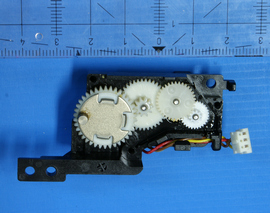 On many (actually most) of our vintage Macintosh of the 80's the floppy drive either is dead or if it works, the disk is not properly ejected. The cause of the latter is nearly always a broken wheel in the ejection gear. Sophie Ramel designed a replacement to be printed on her 3D-printer. A few test at the Massen-Ramel home showed that this tiny replacement worked, and a more thorough test series made in the Computarium confirmed this. Look here for a short album! |
Done. | ||
| Restoration of a Colinbus profiler (CNC machine) |
Baumann Claude (Mar-2021) |
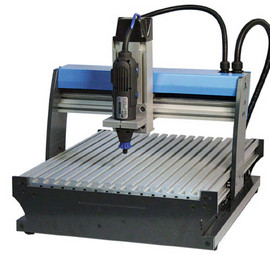 Claude Baumann restored back to life an older Colinbus CNC profiler, an heritage of our late member Jean Mootz. The full procedure, research, investigations,
electronics development and other work are described in a 62-page report
titled "
Bringing back to life a Colinbus Profiler CNC-Router" (46
figures); the report is located in the
Literature chapter of the Computarium web-site, |
Done. | ||
| SCSI HD open heart surgery and Scsi2SD converter |
Baumann Claude Massen Francis (27-Mar-2021) |
The original SCSI hard disks of our vintage Macintosh's
are dying fast, and replacements (on eBAY) are unbelievable expensive and
buying them is a gamble. So Claude and I made an "open heart" surgery on 2
disks that did not spin anymore, or just spun up and shutdown. We openend
the Quantum HD's and the culprit always was a sticking axis of the head
assembly. Carefully putting a drop of oil and cycling up-down, gently
helping the head assembly to make its circular arc movement helped. One of
the 2 works now again with all its contents intact, the other one probably
needs reformatting. We also tried out the SCSI2SD converter card sold by amigakit.com (model 5.2). This is an excellent replacement for terminally ill SCSI HD's. The picture below shows such a card used on a Macintosh SE/30 as system drive 0: works perfectly well! |
Ongoing work. | ||
| HEATHKIT ET-3400A microprocessor trainer and ETA-3400 I/O and memory expansion box. |
Baumann Claude Massen Francis (04-Feb-2021 |
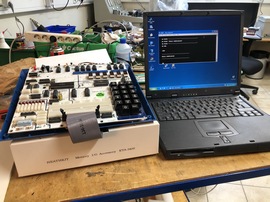 Carlo Mullesch donated 2 vintage Heathkit ET-3400A microprocessor trainers of the early 1980's, and also an ETA-3400 expansion box. One of the trainers was ready to accept the expansion box, but the latter was very ill. The small transformer became burning hot, and the serial communication with a terminal (here an old laptop) remained silent. Both of these items were kits, assembled by a guy in the USA, and so run on 120VAC. The ETA was not fully populated, but the culprit was a blown vanadium capacitor close to a 7912 -12VDC regulator. We replaced both, and after some fiddling with RS232 cables, break-out box etc. finally the monitor prompt MON> showed up. The box has a ROM with a version of TINY BASIC (15 functions and/or commands only, no FOR...NEXT loop, see manual here), which can now be started and sends a greeting: We will mount this combo on a platform having its own 240/120 VAC transformer. |
Repair done. | ||
| Display of PHILBRICK OPamps |
Massen Francis (07-Jan-2021) |
Carlo Mullesch donated a set of original Philbrick GAP/R
OPamps; I made sort of a framed 3D picture of these, to be displayed near
our analog computers.
|
Work done | ||
| Cleaning the big cabinet |
3 persons (06-Jan-2021) |
We finally managed to thoroughly clean our extraordinary
magenta cabinets ( and several smaller ones)where a small subset of the
Computarium's collection is visible all the times. This was 3-hours of hard
work, as the often heavy equipment had to be removed and replaced and we had
to permanently wear our COVID-19 masks. Here a selfie of my 2 helpers and myself and the empty cabinet (this last picture was taken a few years ago).
|
Work done | ||
| INSITE floptical drive of the SGI Indy |
Massen Francis (04-Dec-2020) |
The SGI Indy is now fully functional (but I do not have an original 21MB MO floptical disk, so the drive can only be tested with normal 3.5" HD floppies). |
Work done. | ||
|
SILICON GRAPHICS INDY (CMN B006, made in Switzerland!) See album! |
Massen Francis (Dec-2020) |
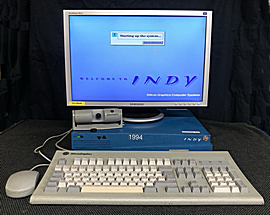 This is the last machine of the contributions by Eric Dondelinger I worked on. Its a very nice SGI Indy workstation with a MIPS R4600 uP, 64 MB Ram, a SCSI HD + floptical, and a digital camera. The machine booted into its outstanding PROM, but the installed IRIX 5.3 was very sick. I looked and found an IBM SCSI HD with the 50pin connector, and installed IRIX 6.2 (found on the truly amazing repository of FSCK Technology). The single IRIX 5.3 CDROM joined was not enough to make a full installation, one needs at leasr 4 CD's. The machine now runs like a charm; there is one remaining problem with the capricious floptical drive (a drive which can read/write standard 3.5 floppies as well as a 21MB magneto-optical disc; I do not have any of these. If you do, please contact me); it has problems with loading and ejecting the disk. This INDY is one of our nicest workstations in the Computarium collection. |
Work almost done. | ||
| DEC3000 M300 |
Massen Francis (Nov-2020) |
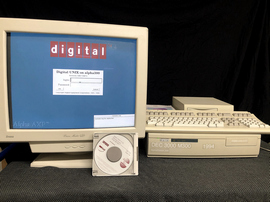 This professional workstation from 1994 was donated by Eric Dondelinger (see below); it was a powerful computer based on the DEC Alpha microprocessor, and is also called Alphastation M300. It did not work, hang during the boot process and changed keyboard keys in a strange manner. The main culprit was the infamous DS1287 Dallas chip with an exhausted cell. I ordered the DS12887A as a replacement, and it worked! Boot was now ok, but the main HD (an 426MB RZ25-E SCSI disk) was terminal ill. I installed Digital Unix 3.2C (which is the first follower of the OSF/1 series) from an external SCSI CDROM drive on the second RZ25-E. The system is now working at perfection, after some strange downs of the power-supply that made my heart stop, but that I was unable to reproduce. |
Work done. | ||
| TEKTRONIX X-Terminal |
Massen Francis (Nov-2020) |
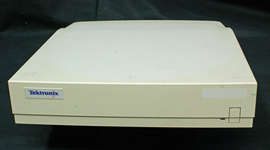 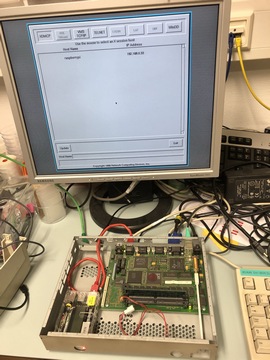
Many years ago (2010 !) our contributor Eric Dondelinger
donated among several DEC Alphastations also 2 X-Terminals from Tektronix
(TEKxp217C). These were used to connect to a big host-server and use its
desktop in a X-Windows environment. Both machines were in good condition,
and I tried to use a small Raspberry Pi as a host. It was a bit tricky, but
now everything runs ok: the X-terminal (based on a Risc processor) fetches
its code through bootp from the server (= the RPi), starts an
X-session which allows either a XDMCP graphical connection or a console-type
Telnet. There remains an obscure font-related problem that I am unable solve
until now: the RPi desktop quality is not good, but a Scratch application
for instance works in A+ quality. If you have any suggestion, please drop a
word at
francis.massen@education.lu. |
Work done. | ||
| Storage works |
Boes Claude Massen Francis (27-Oct-2020) Lichy Waldemar Massen Francis (31-Oct-20) |

We have enlarged our storage rooms, and are installing
many racks to tidy up the huge storage section in the attic of the LCD.
Today (27-Oct) our member Claude Boes and myself started assembling the first 5 of 16
racks. This is heavy work, and we hope that the final result will reduce a
bit the clutter of the storage. |
ongoing work... | ||
| DECmate II |
Massen Francis (Oct 2020, Nov 2020) |
 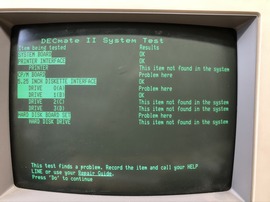 The DECmate II (a 115VAC model from 1982) received from C. Mullesch without monitor and keyboard is now starting to work. I was able to find a LK201 keyboard on eBAY and built a small adapter-box splitting the DB15 cable from the computer (which has both video and keyboard signals) into an Cinch socket (for the monochrome video) and RJ9 socket for the keyboard cable. The 5.25" introduction disk (on upper picture) and the system test disk (lower picture) are bootable and work fine; the Seagate ST-412 hard-drive seems to stuck . None of the WPS disks joined is readable. Both RX50 disk drives are ok, contrary to the test complaining. Restoration is mostly done: I was able to bring back the stuck HD to spinning (don't ask me how!) without ruining the disk, and without loosing any software installed. This is the main MASTER MENU (first screen), a very powerful entry into all the installed four OS's and maintenance/utility programs. Communication via the serial port works good with KERMIT under DOS. The preformatted RX50 disks can be made on an AT using 22disk from Sybex (and putting a 360 KB 5.25" disk in a MF drive). DEC forced its clients to buy preformatted disks, and only later included a full formatting software in its Rainbow microcomputer series when angry clients became louder! The DECmate II has been mounted with all the documentation, monitor, keyboard (in a drawer), transformer etc. on a sturdy rolling table, to ease the demonstration of the working machine. Everything now works at perfection! |
ongoing work... see also lower down!
21 Oct-2020: done!
06-Nov-2020: definitively done! |
||
|
DEC PDP-8/L and MONROE 1920 scientific calculator |
Massen Francis (Sep 2020) |
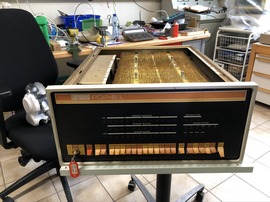 Carlo Mullesch donated (among many other items) a DEC PDP-8/L mini-computer, 115 VAC power, 1968. The backplane has its connectors wire-wrapped, not soldered to a circuit board. As both upper and lower covers were missing, somebody in the past has badly handled the wire-rap pins (about 2600 in total), so that many are bent and make short circuits or unwanted contacts. I started today painfully straightening these up... The last picture shows the many boards inserted in the backplane connectors; the bigger boards located near the center are the two core memory boards (4 KB memory, 12 bit addressing). This mini-computer was sold from 1968 to 1971. I probably will be unable to restore it to working condition, but will try to get help from more knowledgeable people. There are only 5 museums worldwide exhibiting this mini-computer (see for instance here) __________________________________ MONROE 1920 scientific calculator This rare scientific desktop calculator from 1975 (115 VAC) received from C. Mullesch was working, except that it refused to make addition and multiplication. Both keys had bad contacts. Look at the nice Rockwell chips inside! |
ongoing work...
_____________ work done!
|
||
| EXORCISER Copy Station |
Massen Francis (Jun 2020) |
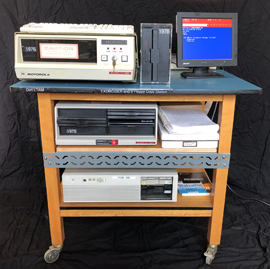
This is the definitive form of our Exorciser-Copy-Station.
A single AT286 is used to interact with the Exorciser (serial, 9600 N 8 1)
using TELIX; the copying is done with the same machine using Dave Dunfield's
Imagedisk (or other software). Writing an image to a 8" floppy works good,
but sometimes floppies that are read into a file show errors when booting on
the Exorciser. I guess the time of head-scratching is not yet quite over...
if it will anytime! The TFT Miracle monitor is a rare MDA/CGA/EGA device (still sold for an horrendous price) ; it would be nicer to use a vintage CRT-terminal, but these beasts take too much of the available space. |
flux state... finished Oct-2020 |
||
| SANYO MBC-555 |
Massen Francis (Jun 2020) |
 Mr. Georges Eicher donated a rare Sanyo MBC-555 computer from 1982. This is a 8088 8 bit machine which was sold below 1000 US$, a world-first sensation. It is not quite "IBM compatible", as a part of the BIOS is on the floppy disk (there are 2 drives, no HD). We received the machine without any software, and booting with a standard MSDOS or IBM DOS disk is futile. So I looked around to find a master image of the boot disk, and found one in .TD0 format. Using the excellent LIBDSK software suite, much tinkering and head scratching, I finally was able to make a real boot disk (also using CopyIIPC). The Sanyo works like a charm, and is in excellent condition. BTW the 2 floppy drives also are not quite standard! |
Done! | ||
| 8" drives on PC |
Massen Francis (May 2020) |
I finally was able to have some success reading and
writing 8" disks from a PC (actually formatting, reading into an image,
writing image on the disk). It took quite some time, and I was close to
abandon this. Using the DBit FDADAP adapter and 8" PS (actually a DC/DC
board), I can now connect to a vintage BASF 6104 drive (DSDD, see first
picture; we received this drive as a donation in 2005) and a still older
SHUGART 800-2 (SSSD, ~1977, 2nd picture, salvaged from Jean Mootz's attic).
This would not have been possible without the outstanding suite IMAGEDISK of Dave Dunfield; his software by-passes the OS (here DOS 6.20) and sends commands directly to the floppy disk controller (FDC), so that the whole bunch of parameters can be individually set. A BIG problem is finding an FDC capable of SD (single density). None of the "newer" integrated controller chips can do this. I have a couple (not many) in stock and finally choose after many tests a combi ISA FDC&HDC controller board from Adaptec (ST506 ATA two cable type, not an SCSI board!), whose FDC chip is known and was tested being capable of SD. As a final test I tried to make an image from an MDOS 2.20 Exorciser disk (SSSD) and write it back on another disk...and ho...Exorciser boots fine from this! One problem is that I do not have many SD 8" floppy disks in the collection, so if you have still some of these dinosaurs lying around, please send me a word (francis.massen@education.lu). This is one of the big joyful moments in retro-computing life, which makes one forget the long hours spent, and also the many adventures which ended unsuccessfully! |
Most important part done, some cosmetic work remaining. | ||
| MOTOROLA EXORCISER System (1978) |
Massen Francis (May 2020) |
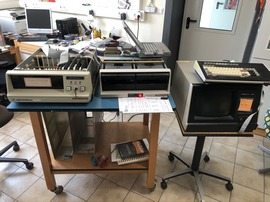
In 2005 we received from the LTAM (Lycée Technique des
Arts et Métiers) a complete Motorola Exorciser
system (6800 based) with MPU, Exorciser II (dual 8" floppy system),
EXORterm150 (terminal) and a printer. I never had the time to correctly look
into this jewel, and started now. The MPU boots into EXBUG 1.2, executes the
MAID command etc... The EXORterm150 has problems, possibly with a half-dead
keyboard encoder. Many keys are not working, but data sent is shown on the
screen. I replaced it for the moment by a vintage laptop running TELIX, and
communication with E-7-1 1200 runs fine. I really must built a 8" copying station asap; I have most material to do, just lacking time, as always... |
Ongoing work.... By an uncredible luck I found one 8" diskette in drive :1 (the second drive), and it was bootable after probably more than 35 years containing MDOS 2.2. After some tinkering, I was able to make backups and generate new MDOS disks (DOSGEN command). MDOS is not MSDOS, but a different beast (Motorola DOS). Thank you "Jacob Schneider" (= name on the label), the anonymous benefactor who forgot this diskette and saved the world! |
||
| Small calculators, software registration |
Massen Francis (Apr-May 2020) |
I am busy upgrading the virtual museum part 3e (pocket
calculators and misc.) and part 3d (mostly PDA's). In doing this, I repaired
quite a couple of calculators that where flagged as "not working".
Most of the times the problem were bad and corroded contacts, or the need to
make an alternative power supply. I often now attach a cable with an USB
power connector, if voltages are around 4.8 - 5 VDC. Than many photos are
made again, often with a supplementary peeking into the open calculator.
This is heavy work, which needs considerable time. On another line I nearly finished the database with all vintage software in our collection (on 5.25", 3.5" disks and on CD/DVD's). We also have a lot of MO (magneto-optical) disks, which a time ago were hyped as the "eternal" backup medium.. well, that seems to have been over-optimistic! The registration of these disks will be done asap. |
Ongoing work | ||
| COMPAQ AP500 workstation |
Massen Francis (Mar 2020) |
 We received quite a lot of vintage Compaq workstations, and all need some tinkering. Most gruesome was the AP500, a sturdy and very heavy workstation from 1999. It's BIOS battery was flat, and horribile est dictu, the guys at Compaq had soldered the coin-cell straight onto the motherboard (metallic contacts were cold-welded to the cell and than soldered to the mainboard). I cut the lower fixation and soldered two wires going to an AA battery-case to the pads. How could such an expensive machine have a such terrible design-fault? (or was this planned obsolescence?). I installed W2k+SP4 on the SCSI disk, and the beast runs very smoothly. |
Done. | ||
| MADAS_AV repaired |
Massen Francis (Jan 2020) |
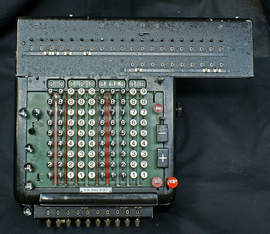 In 2019 Mr. Vic Kolb donated a vintage MADAS 20AV electromechanical calculator (serial 35527, this type was built from 1930 to 1940) which was used in the 1930's by the engineers of the Arbed steelworks in Dudelange, Luxembourg. The machine did not work at all. Thorough cleaning and tinkering has brought it now into a 3/4 working condition: addition, subtraction and automatic division are ok, but I was unable to get the automatic multiplication to work correctly. So we will leave it as is (at least for the moment being). You might look here for an outstanding web-site on the Swiss MADAS calculators.. |
Done. | ||
| Small Videotex player for Minitel |
Massen Francis (Jan 2020) |
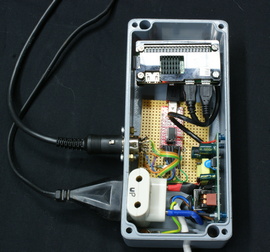
I built a second stand-alone (external) player trying to cram everything in a much smaller case (14cm*8cm) as the first one. This model uses a Raspberry Pi Zero (see upper border), a small open-frame 220VAC/5VDC power supply (right side) and a USB/serial converter (TTL levels) with the Prolific chip. The prototyping board holds both this chip and the 1-transistor level adapter. The white Y-connector is a kludge because I could not find a small enough non-DIN power socket. |
Done. | ||
| MAGIS Club Minitel with broken case |
Massen Francis (Dec 2019) |
I auctioned at eBAY a rather rare MAGIS Club Minitel, probably built in 2002 (agreement date is 2000). This was one of the last models, with a very stylish case and a hinged keyboard. The vendor alas made a very poor inside packaging, so that the plastic case and many items inside the Minitel were broken (more than 35 different pieces! see upper picture.); the keyboard with the front plate was ripped off. By extraordinary luck, the electronics remained in working condition. It took some hours to repair the case and many fixations inside, as for instance the magnetic compensation ring on the collar of the CRT tube. The "repaired" beautiful Magis Club works fine and remains quite sexy. |
Done | ||
| Minitel 1 from 1985 gets inside Videotex player |
Massen Francis (Nov 2019) |
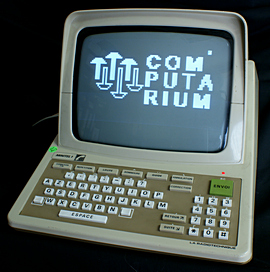
Instead adding an outside box, I tried to cram everything
inside this older Minitel1 case (which has more inside room than the Telic
models). I used a Raspberry Pi Zero, an open-frame 220VAC/5VDC power supply
and the usual stuff. Switching the Minitel on starts the slideshow in a
loop. |
Done. | ||
| TRS-80 Model 1 repair |
Massen Francis (Nov 2019) |
Joel Francois donated his father's first computer, but alas, the
screen showed only garbage.
Replacing the Ram chips did not help, as the
replacement of the few other chips on sockets. I was lucky to stumble on an
excellent article from Marc Brumlik, a former repair technician for TANDY:
"How to diagnose and repair a TRS-80 Model 1" (link).
In this article the exact misbehavior of the computer was described
(pressing the key B shows J), and the cause is a faulty video Ram
(2102 chip, static, 1kbit). These video chips are soldered in, so it took
some work to remove the chip, solder in a socket and put in a 2102 chip from
a defunct 8K memory board of one of our SWTPC computers. Click for very
short video of repaired computer. |
Done. | ||
| Videotex player for Minitel |
Massen Francis (Nov 2019) |
Building a standalone player to show original vintage
Minitel pages on a real Minitel. I used the excellent background and
Python programs by Zigazou,
as well as his on-line creator of Minitel pages (miedit). The player
software is an extremely cut-down version of Zigazou's program, with a few
simple modifications. The device is located in one box (a recup) with a
Raspberry Pi; no changes are made to the Minitel: the box has a power and
DIN sockets for the Minitel, and it auto-starts when connecting to the
220VAC power outlet. I will try to use a lite version of Raspbian, and to test if a RPI Zero will also do the job. Look
here
for a first video of the running player...
|
Basics done. | ||
|
1. MODICON MICRO PLC
2. Minitel as a terminal for the Raspberry Pi |
Massen Francis (Nov 2019) |
1. The rack with the Modicon Micro (612 CPU, outputs all
relay driven) has been modified for better access to the GND and 24V power
rails. The "running lights" program has been modified to allow action
exclusively using the hardware switches, as well to define the bit pattern
and to load, run and stop the program. Program is in RAM, and demo does not
need any computer. Ongoing work with the A350 PLC (with the help of Felix Hansen). 2. I finally found the time to make this happen, following an excellent text by jcquentin (see doc). Works like a charm! Pictures show the interface for the USB serial (TTL) connection and the login screen of Raspbian Buster. |
Done.
Done. |
||
| Lighting: old fluorescent tubes replaced by LED's |
Massen Francis (Oct 2019) |
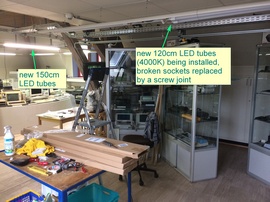 The Computarium was always very "resource-conscious": our main lighting were design lamps from the 1960's originally used in one of the LCD cantines and removed in 2009 for being sent to the scrap yard. Luckily I was able to salvage them for our Computarium rooms, where they are in action since 2009. The fluorescent tubes (FT) lamps were very inefficient, and the coils became burning hot. So we decided to replace the FT tubes by LED tubes, and our lycée takes over the cost. Replacement is simple in theory, but not in practice: many of the plastic tube sockets are broken by age and heat, and can not be replaced as these models do not exist anymore. So when needed the light tubes are fitted with screw joints and the broken sockets removed. |
Going on. | ||
| Repairing a TIM Unitas II (slider model) |
Klein Jean-Paul Massen Francis (Sep 2019) |
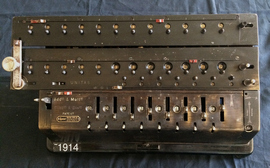 I auctioned a vintage Tim Unitas II calculator (the model with sliders, serial 05753) to complement our collection of Unitas II machines (we have the older wooden case model and the newer keyboard model). The machine was sold as defective, and it was in a bad state. Somebody has dropped it, so the upper carriage was bent and did not slide through, the right indicator on the upper carriage blocked and the crank is broken away. Some prudent work with a hammer and a Dremel grating disk restored the machine to full function. We were not able to fix a new crank, as the remaining hardened steel stub is (for the moment) impossible to remove. The machine can be operated with a screw-driver; not aesthetic but it works. It is a great machine to show the stepped drum and the engaging wheel, as the front cover is very easy to remove . |
Done, except crank. | ||
| Installing a AEG MODICON PLC system |
Massen Francis (June 2019) |
Mr. Felix Hansen donated a rack containing a A350 Modicon
PLC (=Programmable Logic Controller = industrial computer) and two separate
A120 micro models, with DOS based software (Modsoft_AKF) on a Compaq
Presario and a lot of documentation. I transferred the software to a vintage
Maxdata laptop, changed the rack to contain the laptop and one A120 Modicon
Micro (with the 612CPU), seen above the laptop. The A120 runs fine, the AKF
software is similar to the Simatic S5 one (both follow the IEC 61131
standard). |
Work in progress. | ||
| Awakening an old software on a vintage Apple II |
Mathgen Georges Massen Francis (March 2019) |
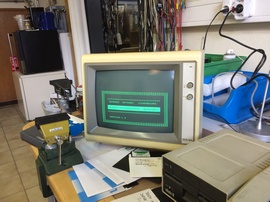 Georges Mathgen wrote in the 1982-85 a complicated program of thermal calculations, running on the Apple II. Today we managed to revive this software on his own Apple II after 34 years. The software uses both 5.25" drives (disk 1 and 2) and many of the Beagle Bros routines for graphics. Two other pictures here and here. |
Done | ||
| Reinstalling and making a Magnetic Storage wall |
Massen Francis, Claude du Fays, Jean-Claude Krack |
As the roof repairs (new Vela windows installed) is finished for the moment, we started to put the Computarium on rails again. There will be some changes in the exhibit, one being removing too much clutter and creating a wall which holds the different magnetic storage technologies as hard-disks, floppies and tapes. Here a picture of the ongoing work: | ongoing. | ||
| BRAILLE Printing Station |
Massen Francis (Apr 2018) |

Finished mounting the Braille Printing Station,
which allows to demonstrate Braille printing on a Index Braille Everest
Printer (model V2) from the early 2000's (this model was manufactured from
1995 to 2003). The sound-proof cabinet has been mounted on
wheels and risen up, so that a vintage Maxdata laptop running Win2k and Word2000 can be
comfortably used to write and print a text. This is a printout of a well known two-liner much in use for checking telecommunications (hint: it speaks of a fox and a dog!). Look if you can decode the characters limited by the blue lines (one character is represented by a dot structure in a 3x2 matrix (3 lines, two columns). |
Done. | ||
| DEC PDP8/i emulator |
Massen Francis (March 2018) |
 I finished building the PiDP8i kit that I ordered in 2016 during the Vintage Computer Festival in Berlin from Oscar Vermeulen and didn't find time to assemble. The kit represents the original console of the DEC PDP 8/I in miniature (300mm x 150mm) with all its switches and lamps. Inside works a Raspberry Pi ZeroW with Raspbian Jessie Lite and the SIMH emulator modified by Oscar Vermeulen and Warren Young (see here and here) emulating OS/8. The kit will be driven by the original ASR-33 TTY, which creates some problems as this old machine is CAPITALS-ONLY and 100 baud. Everything works fine with an old RS232 laptop and Teraterm, the last test with the real TTY will be done asap. |
Done (for the kit) Work going on for the full system. |
||
| ASR-33 TTY sold by Teleprint(Germany) |
Baumann Claude Heirendt Colette Massen Francis (March 2018) |
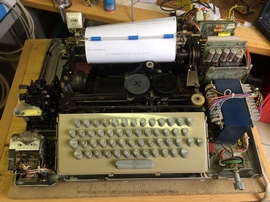 The TTY (serial 325032) is like new, having only 84 hours on the counter. Notice that this model (code is UK804DRE) has a call unit that is quite different from the mess usually seen in US models, and has a sturdy big transformer. Everything runs ok, but the tape reader which worked two or 3 times, remains unresponsive. The search for the malfunction is going on... ...and our member Claude Baumann found the problem: no malfunction, but simply a very sensitive tape out switch which tripped when the tape was fed in from above (and not from below). Preparation work to drive the TTY through a Raspberry Pi Zero, leaving all GPIO pins available for a yet to be assembled PiDP8i kit, is successful, and preliminary tests show the PI0 can serially connect via a Prolific USB-serial cable at the low 110 baud speed. |
Going on... | ||
| Serial communication between Z88 notebook and other computers. |
Massen Francis (Jan 2018) |
The Z88 has a DB9 non-standard RS232 connector;
communication was a bit fiddly to work in two directions. A five-wire cable
with some bridges on one end does the work. Sending a BASIC program into the
Z88 is best done by using a CLI command in its Basic, which takes the data
stream entering through the serial connector as if it was typed on the
keyboard. Picture of the Z88 here. |
Done. | ||
| MACINTOSH SuperDrive floppy |
Massen Francis (Dec 2017) |
 I salvaged a Superdrive floppy from a dead MAC IIsx to replace a non-functional floppy drive in a MAC LC. The drive was dirty beyond imagination. Tedious cleaning, removing tussle, dust and hair and a tiny drop of oil cured the beast, which is now again capable to Read/Write/Format 400/800/1440 kB diskettes (using System 7.1) |
Done. | ||
| Washing and cleaning our Snoopies |
Heirendt Colette (Dec 2017) |
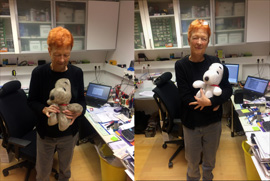 Colette is busy cleaning the last batches of Jean Mootz's Snoopies, so that they may be displayed in a second cabinet. The picture shows the state before and after tumble-washing a beagle: quite a difference! |
Work going on | ||
| MERCEDES-EUKLID Model 21 |
Massen Francis (Nov 2017) |
The Mercedes-Euklid M21 (see April 2017) refused to correctly make the automatic division, after I had removed the carriage for inspection. Help finally came from Prof. Christel Hamann (see his excellent web site here) and M. Rainer Bruns, who sent me the copies from technical pages which showed that I had constantly reassembled the carriage without respecting mandatory steps (unknown to me). | Done. | ||
| MERCEDES-EUKLID Model 30 |
Massen Francis (Nov 2017) |
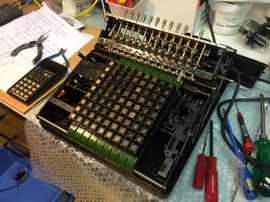 Repaired a Mercedes-Euklid M30 electro-mechanical calculator auctioned at eBAY, which constantly ran into a blocked state. The main cause was dirt gathered around the keys which did not always engage properly, so that a misaligned toothed wheel blocked the proportional levers. I had to dismount all key-columns, which is relatively easy.The M30 has no automatic division. |
Done. | ||
| RS232 file transfer between Husky Hunter16 and PC |
Massen Francis (Nov 2017) |

As usual the RS232 transfer was a bit tricky to set up,
as the usual settings of the COM port through the inbuilt utility was
ignored by the HCOM software, which insisted on a 38400 bit/s default speed.
The serial cable is extremely simple: 3 wires are all what's needed! |
Done. | ||
| Repairing a Continental S9 printing calculator. |
Massen Francis (Oct 2017) |
 A vintage (probably ~1937) printing calculator from the famous Wanderer Werke (Chemnitz-Schönau in Saxony, Germany) was donated by C. Baumann. The looks of the machine are very good, but several number rods were stuck and did not move. Repair was easy, the most difficult part being two very tenacious screws resisting to loosen. |
Done. | ||
| Repairing an IBM 29/59 card puncher/verifier from 1964 |
Massen Francis (Sep 2017) |
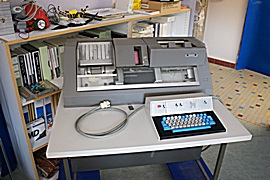 In 2010 we received an old IBM 29 card puncher; a quick test at that moment showed that the machine was not working. After seeing a similar system running at the Computer History Museum in Mountainview (California) I decided to try a "repair". After two days, the first result is that the feeding/transporting mechanism works again (see very short video). There is a serious problem with the keyboard, so I am not sure that a complete restoration will be feasible. |
Work going on | ||
| An vintage electrotherapy device. |
Massen Francis (Jul 2017) |

I found another portable electrotherapy device in the
legacy of Jean Mootz; he had repaired it, but then cut off the power-wires
so that the device was not working. I "repaired" it by adding a new battery
holder and replacing Jean's rather ugly screws by more stylish ones. After
some cleaning the device works beautifully, and the electrical shocks it
delivers can be quite invigorating! The instrument will be used as a
"vintage-atmosphere" enhancement for the Computarium. |
Done. | ||
| A SNOOPIE's cabinet |
Heirendt Colette Massen Francis (Jun 2017) |
 We installed on the 3rd floor a new cabinet with a subset of Jean Mootz's collection of Snoopies, which the Computarium has inherited as a steward.They have been cleaned and groomed with uttermost care and seem quite happy to be again out of the box. |
Done. | ||
| SIEMENS SIMATIC S5 rolling presentation stand |
Massen Francis (Jun 2017) |
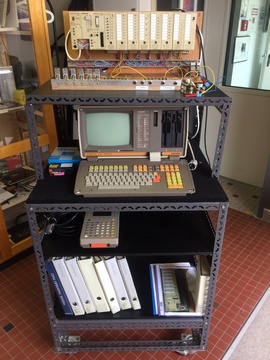 I transformed an existing rolling presentation stand to show the complete Simatic S5 system, together with the PG675 computer, the handheld programmer and the S5-100U PLC. A board with several switches and buttons is available for some quick demonstrations. The raw wooden boards were beautified with black felt and black foil. |
Done. | ||
| Mercedes Euklid M21 (~1938) |
Massen Francis (Apr 2017) |
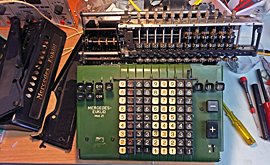 I repaired a vintage Mercedes Euklid M21 electro-mechanical calculator, auctioned at eBAY. The electrical cable was completely rotten inside the machine, and had to be replaced by removing the shut-off board. After a few trials, the machine blocked, probably due to a missing screw on the motor block. Removing the carriage and some fiddling cured this. Inside the machine looks like new, without any traces of rust. The main surprise was a live little spider crawling out of the machine where it had built a tiny comfortable nest. |
Done (probably). | ||
| RetroGameMachines |
Massen Francis (Mar 2017) |
 I finished today the creation of 8 RetroGameMachines, based on HP T610 thin clients running Win7e (Windows 7 starter embedded) with 4GB Ram and a 16 GB SSD Sata disk.. All these second hand computers were bought at eBAY. Eight emulators allow to play a selection of vintage games, using joypad and/or keyboard and mouse. The computers are very robust (no moving parts) and tamper proof, frozen by a write filter. Cloning is easy with a USB stick. Besides the gaming user there is a user "LOGO" to learn Logo (I installed the excellent FMS logo). The machines will first be used at the next LCD Science Déeg (10 May 2017). |
Done | ||
| SIEMENS Simatic S5 |
LEGEL Andreas Heirendt Colette Massen Francis (Feb 2017) |
Our contributor Guy Schintgen arranged a meeting with Mr. Andreas Legel (director of EFG-TA), who has installed many Simatic S5 systems in various big industries. Mr. Legel gave us a very good introduction using our PG675 and S5-100U system, so that many known unknowns have been morphed into simple knowns. Many thanks to Mr. Legel for having found the time to remember and share rare vintage knowledge! | Done. | ||
| SIEMENS PG675 |
Heirendt Colette Massen Francis (Jan 2017) |

We are working on an vintage Siemens SPS S5 system
donated by the LTPEM. The PG675 computer
(8088, 5.25" floppy SSDD drives) runs its original software under
CP/M86-1.2. Communication between the PG675 and the AG (S5_100U) is now ok (03-Feb-2017). |
Going on. | ||
| Archiving Jean Mootz's software legacy |
Massen Francis (January 2017) |
Start of archiving and registering the huge amount of 5.25" and 3.5"disks of Jean Mootz (+2013), which contain many rare software items (like an original of Multiplan 1.0) | Going on. | ||
| Making real 5.25" floppies from Osborne 1 CP/M applications in SSSD (single side single density)format |
Massen Francis (Sep 2016) |
The marvelous Osborne 1a we received had two CP/M 2.2
system disks (5.25" in SSDD) which were easily copied on a vintage XT using
COPYIIPC. No applications as Supercalc, Wordstar, dBase II were joined. I
worked quite some time but was unable to write the common Imagedisk format;
switching to Teledisk and its images in the .TD0 format solved the problem
reliably. See small video (YouTube, 7:26). |
Done. | ||
|
Repair of an EVEREST Multarapid_S printing calculator. Look here for a picture of the assembled calculator and the video which shows the strange multiplication. |
Heirendt Colette Massen Francis (Sep 2016)
|
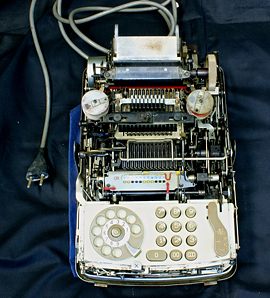 We auctioned a rare Everest Multarapid-S calculator (from Officine Serio, Italy, 1958). This is an electromechanical three function calculator using a phone dial to enter the multiplicator and sort of a handle bar for the usual sub-total, total and negative actions. It was in a bad state, very dirty, with neither multiplication nor zero-keys working. Some metal work with a Dremel was needed. |
Done. There remains an unsolved problem with the multiplicant, which must be entered with trailing 000 to give a proper print-out. A special bar probably defining the grouping of decimals is missing; this would have been activated by the right level marked with dots (see picture of assembled calculator). Also missing is the key-cap to loosen the paper-friction. |
||
| Repair of two Schubert DRV pin-wheel calculators |
Heirendt Colette Massen Francis (Aug 2016) |
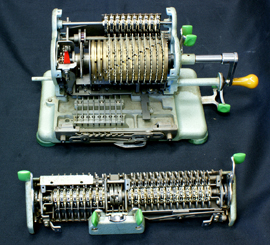 |
Done; one machine does not clear the first right entry due to a tiny broken metallic piece. This is not repairable. | ||
|
Repair of a MONROE Monromatic CSA10 electromechanical calculator (1950's). See YouTube video. |
Massen Francis (Aug 2016) |
 I auctioned a Monroe CSA10 fully automatical 4 function calculator on eBAY; the vendor specified that the machine was broken (motor spins idle). After quite some hours of work and a bit of luck the machine is back to 100% working condition. This is a very nice, compact calculator, in mint condition (no rust, no scratches); it came with an original German Monroe instruction manual. |
Done | ||
|
Repair of a MADAS 12e electromechanical calculator (~1940 to 1943) |
Massen Francis (Jul 2016)
|
I repaired an old Madas 12e, which was donated by Guy Bollendorf in 2006 in an absolute blocked state. A first tentative repair 10 years ago did not succeed, but experience helping, I was able to bring back to working conditions this nice machine today. Several elements were severely blocked by (invisible) hardened grease or oil, and a weakly spring had to be replaced by a twin pair to give the necessary pull to bring back the main black action key. |
Done | ||
| Repair of a Sinclair QL and a Commodore 64G |
Massen Francis (Jun 2016) |
A Sinclair QL had a non-working keyboard, due to the
usual problem with vintage membrane keyboards: brittle plastic and broken
conducting lines. The membrane was replaced by a new one bought in the UK.
The QL works good, and can even read the microdrives. The C64G had a missing keycap + spring: the spring pushes the key up, so it is important as otherwise every slight tremor activates the key. A key from a dismembered C64 was used as a replacement (the color is brown instead beige, but the C64G works fine). |
Done | ||
| Repair of BBC Master power supply |
Massen Francis (May 2016) |
Yesterday (11 May 2016) two BBC Master computers used
during a LOGO workshop started blowing acrid smoke...most probably due to a
power-supply going bad. Inspection today (12 may) confirmed: a filter
capacitor has exploded: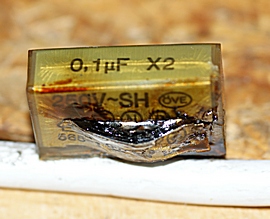 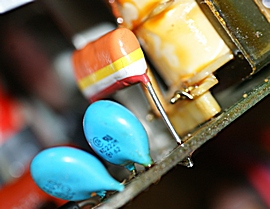 As I had not a correct rated (100nF) foil capacitor at hand, I used a 330nF replacement...and it works! I will try to go back to a correct X2 type, and probably replace the 100nF and 10nF caps on all our Masters (time permitting). Sprow's webpage was a great help. |
Done. | ||
| Restoration of a vintage IBM 5150. |
Massen Francis (Feb 2016) |
This is a rare original IBM 5150, the first "real" IBM computer after the IBM Junior. Has a DIN connector for an audio cassette player used as storage. Runs now PCDOS 1.1. |
Done; ATI GS+ graphics card not yet running (missing documentation on Dip switch settings). | ||
| Naked HP25 display |
Massen Francis (Feb 2016) |
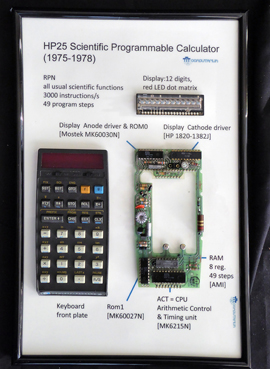 A non working HP25 has been disassembled and the different elements put into a frame, so that the 5 IC's can clearly be seen. |
Done. | ||
| GENAILLE-LUCAS rulers ("bones") |
Massen Francis (Feb 2016) |
 I finally build two sets of Genaille-Lucas rulers in a form that is similar to the Napier-Bones. I found wooden prismatic rods in a market, and adapted the template using Photoshop. Kudos to our member Claude Baumann who found an error in one of the division templates (ruler 7, look at 6) from the GERMEA group of the University of Pau. The beautiful boxes were bought from Amazon. |
Done. Some minor cosmetic changes will be made if time permits. | ||
|
MOVIT 913B line tracking robot. See two videos on YouTube: the first shows the robot following a very large and simple track, In the second video the track detection has been optimized and the robot must follow a somewhat nasty track. |
Massen Francis (Jan 2016) |
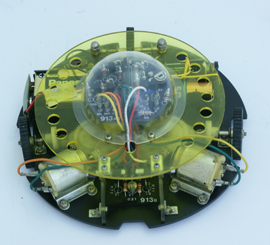 Claude du Fays donated a vintage MOVIT line tracking robot he received in assembled state a long time ago from a computer dealer in Belgium. The MOVIT 913B was sold as a kit, probably in 1984. It is a non-programmable device whose only function is to follow a black line. This item was in a very bad state: both batteries (2 AA cells for the motors, a 9V battery for the electronics) were totally corroded, had expanded to crack their holder, and the corrosion hat eaten away many contacts. One of the little motors was blocked. |
Done. | ||
|
IBM 5160 (IBM XT) with 256 kB Ram, 1985. See other other pictures here and here (the machine has two graphics cards: a CGA and a MDA/parallel combo). |
Massen Francis (Jan 2016) |
 In late 2014 our contributor Pol Hoelzmer brought in an IBM 5160 (the original IBM XT), that I was unable to make running: the screen remained dark! Changing the power supply and removing all boards did not cure the problem. I resumed this work today and rapidly found the cause: one of the two floppy drives had an electrical short and brought down the power supply. I did not find the fault on the floppy drive, but replaced the culprit by another original IBM model (from Jean Mootz's attic). Everything now works ok, the computer is in a very good state. |
Done. | ||
|
GENAILLE-LUCAS rulers See short album. |
Massen Francis (Jan 2016) |
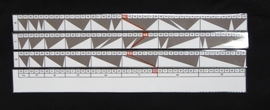 For our next upcoming workshops I built sets of Genaille-Lucas rulers. There are different rulers for multiplication and division. The picture shows the multiplication of 916*7 = 6412. |
Done. | ||
| BINARY LOGIC/Arithmetic Module |
Massen Francis (Jan 2016) |
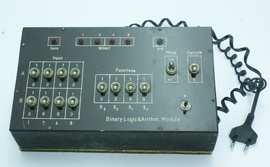 A binary logic and arithmetic teaching aid built by the late Jean MOOTZ in 1973. Contains only two IC's: a SN74181 and a SN7404. |
OK! | ||
|
Heathkit EC-1 educational analog computer (1960) See album and video ( YouTube, 11 Jan 2016) |
Tholl Raoul Massen Francis (Dec 2015) |
 Only one channel (of 9) was working ok. Many wires broken at the points of solder. All valves ok (surprise!). Some balance potentiometers a bit "scratchy". Linearity of ramp integrators is good (check done with a vintage Heathkit IR-5207 XY plotter). |
All channels ok. Still to do: 1. Replace old electrolytic capacitors 2. Make plug modules with R and C. January 2016: Capacitors replaced, a first set of modules made. |
||
|
Corona Portable . See album. |
Massen Francis (Dec 2015) |
Printing calculator from the1930's. Was in a very bad state, non working |
Minimal restoration. Works good. | ||
|
Milton-Bradley BIGTRAK More see here. |
Massen Francis (Dec 2015) |
I bought this vintage 1980 programmable truck from ebay UK some time ago: it did not work correctly. Main problem was misaligned rotation sensor, broken battery-holder plate and shaky battery contacts. This truck has a TI TMS1000 4-bit microcontroller with about 160 available bits of Ram on its board. |
Works good! | ||
| Raspberry Pi2 |
Massen Francis (Sep 2015) |
 with 3.5" Tontec TFT touchscreen and Rii mini-keyboard (wireless keyboard with touch-panel). The pink case is a Cellularline power box (4400mAh, max. 2 A). Screen shows graphical desktop of Rasbian-Wheezy. |
Works good with Rasbian-Wheezy, but Retropie Dispmanx based Emulationstation refuses to display on the Tontec TFT. | ||
|
1. Rasperry Pi Retropie 3.0 2. Monroe CSA-8 3. Win286 |
Massen Francis (Aug 2015) |
1. I configured a Retropie v.3.0 Rasperry Pi to see how
it could work as an emulation station during a possible workshop. The big
problem remains the controller (I use a Microntek USB controller) and the
many different handlings of the controller by the emulators and the
games. For the moment, I am still not 100% happy with this. (Solved, ok now
17Sep2015). 2. I auctioned (very cheaply) a Monroe CSA-8 fully
automatic electromechanically calculator from the 1950's. It is in a bad
shape, and after having spent many hours (and removing the carriage), I am
still unable to get the multiplication and the division working properly. |
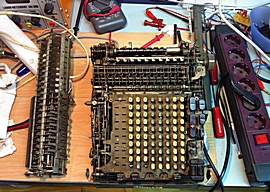 |
||
|
BELL PUNCH PLUS Sterling See album. |
Massen Francis (Aug 2015) |
Restoration of a rather unique Bell Punch Plus "Sterling
& Farthing" adder. Many missing rubber dampers, one missing spring, and a
lot of dirt. |
Ok. | ||
|
EDMUND Analog Computer See album. |
Massen Francis (Jul 2015) |
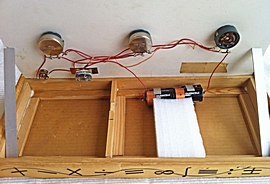
An Edmund Scientific analog computer bought at eBay USA
came in a non working state This primitive device has only 3 potentiometers,
a push button switch and a galvanometer. The cardboard case badly needed a
wooden frame to give some stability. One of the 50 Ohm wire potentiometers
had broken contacts, and one of the contacts of galvanometer broke away. The
plastic hands on the dials also were broken off. |
Repaired: made wooden frame inside of box, repaired push button switch, galvanometer contact and right potentiometer. This should be replaced, as the soldering caused of windings some loss at the start and the end. Plastic hands glued to dial knobs. | ||
| COMDYNA GP-6 analog computer |
Massen Francis (Dec 2014) |
Finished with repair. Modifications: new display (multimeter
with voltage divider), added
internal 220/117 VAC transformer and separate power supply for the
multimeter (must have different ground), repaired banana and power sockets.
|
Tests in "POT" mode are ok, all OP's seem ok, but
remaining problems in "OPERATE" mode. 26Dec2014: The GP-6 now solves the system of 3 non-linear differential equations of the Lorenz attractor. Practically all resources of the GP6 are used. The scope shows the YZ cut through the 3D figure.
15Dec2014: |
||
|
Tests on the AMF665D analog computer. See video. |
Massen Francis (Oct 2014) |
Testing this nice analog computer. I made a quick
programming for a damped oscillation (i.e. a differential equation of the
type k3*y"+k2*y'+k1*y = 0). Click on the pictures to see the calculation
scheme, the patch cables defining the scheme and the result on a Fluke
digital oscilloscope.
|
The AFM665/D has been fitted with a small 220/110 step-down transformer (located below the grey plate at the lower right corner) to allow plugging into a 230 VAC power outlet. | ||
|
1. A repaired FACIT ESA0 was mounted in the nude into a
plexiglas enclosure; when executing operations on this machine, the sight of
the inner workings is quite amazing. 2. The educational analog computer AMF665D has been repaired |
Massen Francis (Sep and Oct 2104) |
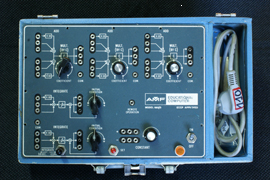  ...and fitted with a European power cord. Most blocks worked fine, but one 741 opamp was dead and has been replaced. This computer has 3 modules for addition/substraction and 2 modules for integration. The pictures show the switch board and the electronic boards. |
Facit ESA0 done. AWF665D needs three missing knobs (done), and eventually an additional step down 220/110 VAC transformer to make an external transformer unnecessary (done, 22 Oct 2014). |
||
|
Update of virtual museum See album of Hamann Manus R |
Massen Francis Heirendt Colette (Aug 2014) |
Busy month with ongoing update of virtual museum (new items, and many new photos and albums). Also some repairs, one being that of a Hamann Manus R which had 5 broken wheels. | ongoing work. | ||
| A FACIT ESA0 electromechanical calculator (~1952) is back to working. |
Massen Francis (July 2014) |
We have 2 ESA0's, and one of them was "repaired" in March 2012. Actually, this was short lived, and a later trial showed both machines completely blocked. After spending quite a lot of time, one of these beautiful calculators (which counts 2200 parts!) is running smoothly again. It will probably be put into a transparent enclosure to be able to securely watch the rotating wheels and clanking levers. See videos: part 1, part2, part 3. | Mostly done; transparent enclosure will be made later. | ||
| Repairing an unbootable IBM 5155 |
Massen Francis (Mar 2014) |
A luggable IBM 5155 from 1985 did not boot from floppy drive A. Repair was easy: some thinking and a very small amount of oil. See album. | Done. | ||
| Repairing several Canon BJ300 bubble jet printers |
Massen Francis (Mar 2014) |
The preparation work for our next Logo workshop in April
is now finished. We will use vintage BBC Master computers (1984) holding
Logotron Logo and the Printmaster Eproms. The Printmaster contains a
screen-dump function that is mandatory to make a paper copy of the Logo
screen. Vintage bubble jet printers from 1991
(donated by the LTHAH) will be used, as these dot-matrix printers are
reasonable fast. Making them work was quite a job, as the ink channels and
print heads were thouroughly blocked. |
Done. | ||
|
Repairing a vintage Valiant Turtle from 1982. See two small YouTube videos here and here and album. |
Massen Francis Schintgen Guy (Jan 2014) |
The son of our late member Jean-Claude Asselborn donated
some BBC material to the Computarium; among these items was a Valiant
mechanical, remote controlled Turtle. It is probably one of the first models
from 1982. The 10 individual AA NiCad batteries were dead, there was no
software and no manual. We had some electrical problems with very bad
contacts, but finally brought the turtle back to life with new NiMH
batteries, some tinkering, an old diskimage of the Valiant Mover software
found on the internet and a working BBC. mod.B. |
Turtle is back to life! | ||
| Repaired a Texas Instrument Silent700 terminal |
Massen Francis (Dec 2013) |
We received a TI Silent terminal (~1971) as a donation from C. Ritzerow; this machine was an electronic successor to the mechanical ASR33 and has an inbuilt thermal printer and an acoustic 300 baud modem. The mechanism for moving the print head was broken, and I spent quite a lot of time trying to fix it. As the female power connector was unusual, I installed a standard EU cable | Printer works now, but the acoustical modem seems to be dead. | ||
|
Repairing a NISA PK5 calculator Video |
Massen Francis (Aug 2013) |
I auctioned (for a good price!) a NISA PK5 4 function electromechanical calculator. As usual, the automatic division did not work, so I opened the machine (which needs removing the carriage) and after some fiddling, the automatic division works most of the time. Look this video on YouTube which shows the funny movements of the carriage when 88888 is divided by 3333. | in the works | ||
| Repaired vintage Pong game and Albums |
Massen Francis (July 2013) |
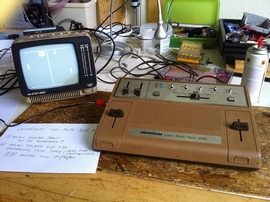 G. Laures donated a German UNIVERSUM Color Multi-Spiel 4106, which is a PONG from 1977 sold by Versandhaus QUELLE. There was no power supply, a flaky ON/OFF switch and a bad power connector. The game made many noises on powering up and did enter rarely a working mode. Disassembling the "keyboard", blocking the ON/OFF switch in the ON position, making a new power input with reverse polarity protection and driving the game with a much lower voltage than 9V cured the problems. Work on the albums continues: this is a time-swallowing job, as the machines must be cleaned, tested and photographed. On the next upgrade of the virtual museum links on the pictures will lead to the album (where available). Look here. |
Mostly done. | ||
| Cleaning and repairing a Brunsviga RK13 |
Massen Francis (June 2013) |
The last workshop showed that we need several more
Brunsviga RK13, which have become sort of a standard for our mechanical
calculation workshops. I bought one on eBAY (these machines do become really expensive!), but it came in a very dirty state, and an only partially working carriage displacement lever. Nevertheless, all major operations are ok. |
Cleaning nearly finished, left displacement of carriage tricky with the right lever, but ok with the front button. | ||
| Cleaned and tested Compaq Concerto computer found in the attic of Jean Mootz. |
Massen Francis (April 2013) |
 This is one of the first "tablet-like" computers from 1993. The whole computer (main-board, HD, 3.5" floppy) is contained in the touch-sensitive screen, which reacts to a wireless pen. System was "MS Windows for Pen Computers 1.0". On this machine DOS 6.2 is installed, and the stylus is missing. One hinge is broken off; LCD screen is very dim (screen shows a Mandelbrot picture being drawn by a GWBASIC program... very slowly!) |
Nearly finished. | ||
| Albums of new donation. |
Massen Francis (April 2013) |
Started making albums of the most interesting computers from the huge donation by Gérard Laures (April 2013). See here! | Ongoing work. The albums will be referenced from the slides in the virtual museum. | ||
|
Restoration of a vintage MBLE tuner + amplifier from 1964. See the album and video. |
Massen Francis (Mar 2013) |
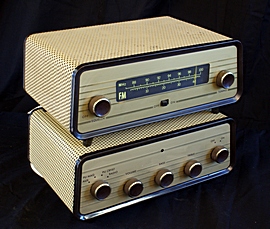 I found this very retro design ensemble in Jean Mootz's attic. He assembled this valve driven pair (sold as a kit by famous Belgium company MBLE) in 1964. Restoration was mainly cleaning and changing voltage from 130 to 220 VAC. Will be installed as a retro decorum in the Computarium. |
Finished. | ||
|
Restoration of a vintage Radiostat violet wand. See the album! |
Massen Francis (Feb 2013) |
I found this device in a cabinet of the physics lab. Cabling was in very bad shape. The wand is not quite so nice as the Norisan, but it is functional again... and it is an item that the famous Powerhouse Museum in Sidney, Australia, also has in its collection! |
Finished. | ||
|
Restoration of a vintage Norisan violet wand. See the album! ( also YouTube video) |
Massen Francis (Feb 2013) |
From time to time switching from calculator or computer repair can be a welcome distraction. I found in Jean Mootz's attic an old 1931 German electrotherapy device (a "violet wand") that was not working. Repair and cleaning were not too difficult. J. Mootz probably had it running on 110 V in 2001, but meanwhile two wires were broken and it was well hidden among the rubble |
Finished. | ||
|
Siemens & Halske railway Morse telegraph. See album. Also look at this marvellous collection of old telegraphs from Fons Vandenberghe.. |
Massen Francis (Jan 2013) |
Restauration of a vintage Siemens & Halske telegraph, which was used at a railway station. Thorough cleaning, some slight changes in wiring to operate device with one single battery, searching and finding a paper tape as replacement of the original. |
Almost finished. | ||
| Virtual Museum web pages |
Massen Francis Heirendt Colette Massen Florence(Dec 2012) |
Change of conversion software to produce html pages that look ok on all browsers and tablets. Update to include new items. |
In progress. See here. |
||
|
MERCEDES Addelektra |
Massen
Francis Baumann Claude Krack Jean-Claude Klein Jean-Paul (October 2012)
|
Three of us were unable to assemble the electrical motor
correctly but Claude found the trick. The reassembled motor ran for a very
short time, but than blocked as the bearings seem very used. A second
problem is the flaky insulation, which makes using this engine during a
demonstration an impossible risky adventure. |
New motor installed, runs ok.. | ||
|
MERCEDES Addelektra This
booking machine from 1930 (serial number 4708) was in a bad shape, extremely
dirty, and the electrical motor removed and disassembled. The beautiful
photographs at eBAY surely were made a long time ago, when the machine
was still in better condition. |
Massen
Francis (October 2012) |
Machine as auctioned on eBAY:
Machine after heavy cleaning, oiling an minor repair (original motor replaced by a temporary one):, upper part switched back: |
Getting the machine to operate at least as an electrical
typewriter was heavy work. Jean-Paul Klein and myself are unable to reassemble the original single-phase AC motor (does the cage-type rotor belong to the same motor?). It will probably be replaced by a new one, as most electrical wires in the stator are in a bad state. The two counters are not yet working (they are clipped to the front at the columns where numbers are typed, and add these numbers). The lower numerical keyboard is working again, albeit somewhat roughly. |
||
|
Heathkit chart recorder EUW-20A
from 1967 See short album and YouTube video See also here at the website of EarlyComputers I continued the
14/15th June with chart recorders, audio generator, frequency scale/counter
and digital multimeter. |
Massen
Francis (June 2012) |
Machine was extremely dirty after spending > 40 years
under the roof. Mercury reference cell was broken loose and empty. Replaced
by alcaline cell.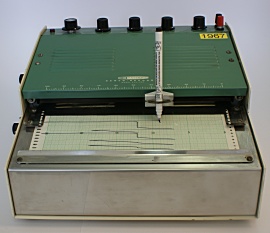 From time to time it is a great fun to return to working condition items that are not computers or calculators. I spent two days cleaning and repairing a vintage Heathkit chart recorder EUW-20A from 1967, found in the attic of Jean Mootz. This marvelously designed analog Y-T recorder has full scale inputs from 10mV to 250mV. Three vacuum tubes (one 6BQ5 and two 12AX7) make the amplifier. |
Ok, works fine. | ||
|
Repaired two Quickshot SVI-2000 robotic arms (1985)
donated by Jean Mootz Labview program to control the Robotarm from a PC in works by Claude Baumann. See You Tube video here (from another web-site) |
Baumann Claude Massen Francis (March - May 2012) |
One had been modified by J. Mootz to enable powering
by external (+3)-0-(-3) VDC. Some movements were blocked. Dismounted base
and main arm; resoldered/lenghtened some wires. Relatively easy to dismount,
tricky to reassemble this el-cheapio robotic arm, which is driven by 2
joy-sticks. Second arm modified for external power-supply and repair. Electronic board to drive through parallel port PC interface tested with several programs..
|
Repair done, programming in the works. | ||
|
1. Repaired/tested a lot of XT motherboards (8088 type)
and big old 5.25" floppy drives.
2. Finally brought to working state a FACIT ESA-0 fully automatic electromechanical calculator (from the fifties, see here) |
Massen
Francis (March 2012) |
1. Boards will be used in a future workshop, so this is
work done in advance. 2. This was quite a bit of fiddling: the whole machine was blocked rock-solid. Many hours and much oil! |
in progress Mostly done |
||
|
There has been so much going on, that I do not find the
time any more to update this correctly. So here a short resumé
|
Massen Francis (22 Jan 2012) |
- made RGB -Peritel connection of an ORIC Atmos
microcomputer (one difficult to find trick) - checked, cleaned and restored Commodore 1541 floppy drive and several C64 computers - checked Olivetti Envision 400 system - cleaned, repaired (partially) "Supertotalizer" Comptometer - assembled many new boards for storing equipment - ongoing repair of 3rd ASR33 (tricky) and much more.... |
done | ||
| GOUPIl Golf SX had exhausted battery in DALLAS 1287 RTC chip | We received a very nice French semi-portable Goupil Golf SX (1989) from the Lycée Charlemagne in Thionville. Alas, it has a soldered Dallas RTC chip with an inside exhausted BIOS battery. The location of the chip made the repair instructions found here and here impossible to follow, so a new third variation of the theme had to be done. It is tricky work. See album. | Repair done, Goupil works flawlessly again. | |||
| Finished restoration of second ASR-33 (115VAC model) |
Massen Francis (18May2011) |
 Jean Mootz donated a second ASR-33, a model with quite some differences from the previous one (as someone said: "2 ASR-33's are never the same"). As the first ASR-33 developed some nasty mechanical problems (intermittent blockings) I decided to use this one with the OSI500. I first built a new +5/-9 VDC power-supply for the OSI500, using an old ATX PS and a switching PS from Conrad Electronic. I made a hybrid of these 2, which was not without some pain. The OSI is mounted at the right side o the hollow TTY stand, which contains a step-down transformer, a separate PS for the tape-reader, the kludged OSI PS and a dual 230VAC outlet. The stand has to be closed for obvious electrical security reasons (the connectors of the 230/115 transformer and the tape-reader PS are blank and accessible!). The ensemble works fine, with the exception of the tape-reader (reads but characters are gobbled). There is also a second non-lethal flaw: the calling drum (which should be activated only if the "Hereis" key is pressed or "WRU" (who are you?) code is received, is always engaged. I had to immobilize its switches to avoid garbage from two set of switches working at the same time. From time to time the TTY goes into an "absent" mode, with the magnet on the receiver side refusing to work (or a mechanical clutch blocking its function...). Both problems will have to wait before being corrected. Look here for a short album. |
TTY with attached OSI500 throughly cleaned and mounted an
rollers, ready to be shown in action. Tape-reader, calling drum and "absent" problems not yet solved. No source for 8.5" perforated paper roll (or fan-fold) for sprockets found here in Luxembourg (if you have some old US paper, please tell me!). Will use A4 fan-fold paper with right side cut off; holes on left side suffice for correct guiding (with some helping hand). Work on the first TTY will resume asap. |
||
| Built RS32 - current loop converter |
Massen Francis (15May2011) |
 As the OSI500 is the only device having a current loop serial output, I wanted to built a general RS232 -20mA CL converter. This enables to drive the TTY by a laptop. I found a good and affordable kit for an active CL interface here. There was some head scratching regarding active and passive CL, Tx and Rx and polarity (yes!). Click on the above figure for the layout with the proper connections to the DB9 socket of the PC RS232 port and the terminal strip of the TTY. I was happy to find an old copy of the marvelous MICROLINK communications software (Win95), which is capable of 110 baud and 7 databits, whose existence seems to be forgotten by many more recent programs. |
Finished. | ||
| Brought OSI500 + ASR-33 TTY to work | Massen Francis |
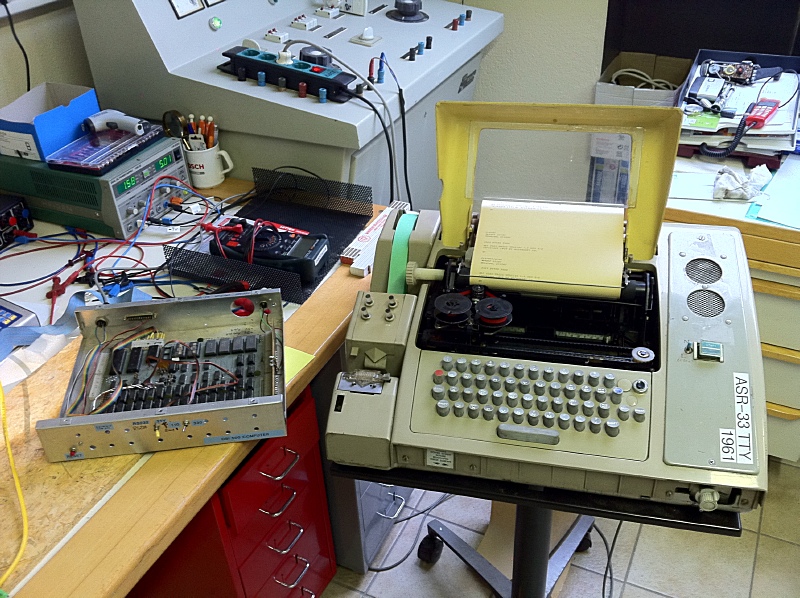 Making the OSI500 to teletype assembly working was a bit tricky. The OSI has no crystal controlled oscillator (only a cheap 555 based circuit), so getting the 110 baud right asked for some fiddling (change of potentiometer, new toggle switches...).The serial line to the TTY is of the 20mA type, and the 1977 vintage OSI is laid out for this (he also has a regular RS232 output). Look here for an album and a video.(m4v, 25MB) |
Basic repair and cleaning done. OSI will be mounted with a new power supply (+5V, -9V) into the original stand of the TTY. | ||
| Installed Home PC corner | Heirendt
Colette Massen Francis |
 We installed a cosy home PC corner, laying out some carpet and exposing a working TRS80 system (1977-1983), a Philips vintage Pong game (1977) displayed on a vintage black/white Sony TV, and a working BBC Master2 system (1986) |
Mostly done | ||
| Privately bought a Millionaire calculator | Massen Francis | A very beautiful working calculator (serial 4201, probably around 1920), bought from Antikma. | Needs some cleaning. | ||
| Repaired
a totally blocked Brunsviga 13RK Repaired a 2nd Brunsviga 13RK whose reset to zero was not working Repaired a Odhner Original who had one blocked button to move the carriage |
Massen Francis | Mostly a work of patience, cleaning, oiling an slight bending | All 3 machines ok now.Brunsviga 13RK will be displayed "naked" to show the inner workings | ||
| Work on the ASR33 teletype | Massen Francis | Trying to make the teletype interact with the OSI computer | Baud rate (stability?) problem still unsolved. | ||
| Major transformation of the TC | Massen F. and Heirendt C. | The bureau/workshop part was displaced into a new, separate refurbished room. Visitors are such spared the view of creative chaos inevitable in a workshop! | Finished | ||
| Work on the IMSAI 8080 | Mootz
Jean Massen Francis (28Oct10) |
We have the computer running (lights blink, stop/go/single step seems to work) | Terminal attached (computer using Hyperterm) gives no answer. Did not found time to study the doc. | ||
| Repaired Triumphator CRN2 | Massen
Francis (20Oct10) |
Three faults made the machine not working: two missing nuts and one partially blocked slider of the clear-all mechanism. |
In good working condition now. | ||
| Installed LED
lighting in exhibition shelves |
Baumann Claude Massen Francis (19Oct10 to 21Oct10) |
We mounted LED-strips to give a better impression of the machines exposed in the blue shelves. A problem was to avoid being blinded by the visible upper row strip. Solved by mounting it into a cable-channel. | Finished. LED's switched on by wireless operated outlets. | ||
| HP2100A
now exposed as first visible item |
Baumann Claude Massen Francis (19Oct10) |
The HP2100A was the first (mini-)computer ever used in a Luxembourg school (1973, introduced by Prof. Jos Lahr). So it stands out as one of the most precious items of the collection. |
We
built sort of a semi-boot, so that the display enhances the structure of
the computer. Before entering the Thesaurus Computarii, this is the first item to see. |
||
| Put SBC Mazel II back to working |
Massen Francis (16Oct10) |
 |
We received this board from contributor N. Malget. It had no power supply, and the pin-outs of the connector were not marked. An email exchange with Silicium was only partially helpful, so a more rigorous investigation led to the solution. Contributor F. Thillen donated an self-built power supply with the needed +5V, -5V and +12V voltages. Board is again in mint condition. | ||
| Exorset30 system now booting |
Massen Francis (15Oct10) |
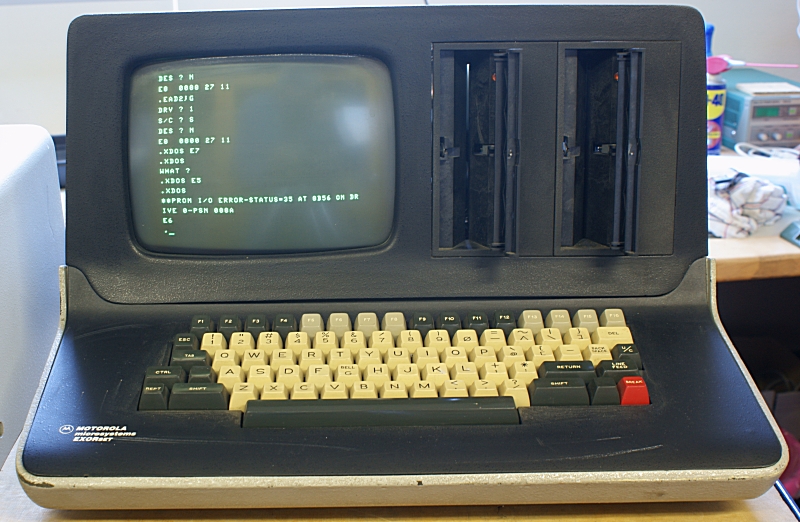 |
This
marvellous system donated by N. Malget refused to boot into XDOS and
BASICM. There clearly is a problem with the first 5.25" floppy disk.
Making the 2nd disk the boot disk solved the problem. Repairing or reclaibratiing the other disk remains to be done. |
||
| Put HP 7585B A0 plotter to work. | Baumann Claude Massen Francis (06Jul10) |
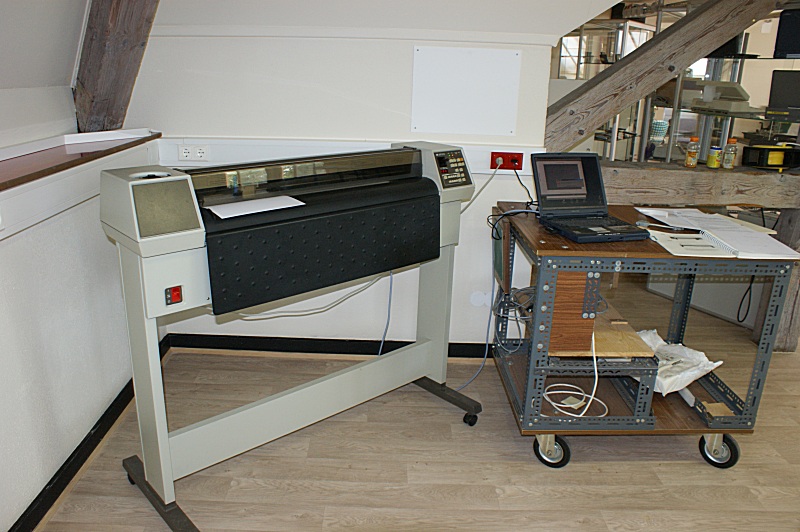 The big A0 plotter donated by C. Bechoux did its demo flawlessly, but we were unable to drive it from a computer |
Problem solved with new RS2132 cable and many fiddling on the different setup parameters. The plotter works from Windows XP Pro through Roland HPGL drivers or (what is our default) through the Winline HPGL drivers for Windows. | ||
| Installed
shelves and show cases in the TC. Some more painting and wood work. Started final cleaning before moving objects in. |
Baumann Claude Massen Francis |
The main room is now almost ready. Installation will start in two weeks. Most objects will be installed after the summer vacations (in September-October 2010) | |||
| Repaired MADAS 16LS calculator | Massen Francis (12Feb10) |
I bought a MADAS electromechanical 16LS calculator on eBAY. It was in a very good shape, but, as common for eBay goods, didn't work. The machine was blocked, one key-columns showed one unit to much (pressing key 1 displayed 2). I dismounted the casing and carriage and with a bit of luck, inspection and WD40 put the whole thing back to correct working. I was unable to complete a division, but this too was solved with the help of Computarium team member C. Heirendt. | Working again 100% | ||
| Lighting in room #2 of the TC | Massen Francis Baumann Claude (03Feb10) |
We installed the full mounty of all nice lamps of the LCDNB restaurant that I managed to salvage. There was a nasty problem with excessive current (a 132W rated lamp uses ca. 400W) that has been solved through rewiring. | Done | ||
| Works at the TC progresses as planned. | Massen Francis Krack J-Cl Jean Mootz |
Room#1 is finished, as well as
major repairs in room#2. Approx. 500 working-hours invested up to now. Look at an album here! |
Painting and electrical wiring will be done next. | ||
| Heavy work at the Thesaurus Computarii (TC), the storage rooms in the attic of the LCD | Massen Francis Krack J-Cl Baumann Cl. (19Sep09) |
Provisional gathering of all material in first part of the attic. Wood work, painting, LAN, furniture, lightning. | First room (administration, repair shop, large vitrine...) almost finished | ||
| Repaired an Olivetti Summa15 printing calculator (donor: anonymous) which was in a very bad shape. | Massen Francis (Feb 09) |
Will be used as an open machine to see working innards | Working again 100% | ||
| Tested 2 Russian electronic pocket calculators from the Elektronika series. | Massen Francis | No batteries anymore but... | In good shape. | ||
| Repair in progress on machines donated from N. Friob. | Mootz Jean Massen Francis (Dec 08) |
Many of these machines are not
working. Started with electronic booking machine from Olympia; printing works intermittently, cause as yet unknown. Diehl, Marchant, Facit thoroughly blocked... |
Repair in progress | ||
| Repaired a Hamann Elma |
Massen Francis (Dec.08) |
Old Hamann Elma bought from eBay (link to picture, not actual machine!). Was in bad shape. Electrical motor had one missing carbon contact, bearings were blocked. | |||
| Restaured Olivetti Divisumma 15 |
Massen Francis (Nov.08) |
Machine was very dirty, but mostly functional after some fiddling. Cleaned, checked. | Working again 100% | ||
| TIM UNITAS bought | The AALCD (=Amicale des Anciens du LCD) financed two major acquisitions: a very old TIM UNITAS calculator and a newer Brunsviga D13R dual rotary calculator used in geodesic work. | Both machines working 100% | |||
| We made a major successful bid on eBay for about 20 old calculators, all from a single collection. All are in a very "dusty and rusty" state, none is working as is. | Mootz Jean Massen Francis |
Olivetti Divisumma 24 repaired and
working at 98% Olivetti Divisumma 26GT working 100% Rheinmetall printing adder (beautiful old black steel) repaired and working. Facit electromec. calculators (2) partially working Old Olympia calculator with Nixie tubes: no success, but Nixies are lighting up. Also repaired a non working MONROE LA7160 from another bid. |
Ongoing work | ||
|
The Cirque des Sciences left us
with a legacy of broken-down machines, which did not survive the children's sometimes brute force |
Mootz Jean Massen Francis |
Several big 4 function calculators
are blocked, as well as a couple of rotary machines. |
Big Friden electromec. and several rotary calculators repaired | ||
| Building an RS232 interface to connect an old Siemens telex to a PC | Baumann Claude Massen Francis |
Baumann Claude (with minor help from FM) designs a microcontroller (PIC) driven interface; the very complicated programming is made in Labview. The method used is VERY unorthodox! | Telex to PC ok PC to Telex still problems |
||
| Some pictures of the repairshop |
Massen Francis Mootz Jean (2008) |
Many repairs going on. Last success: Cellatron R44SM | Still much to do! |
last revision 08 Mar 2024